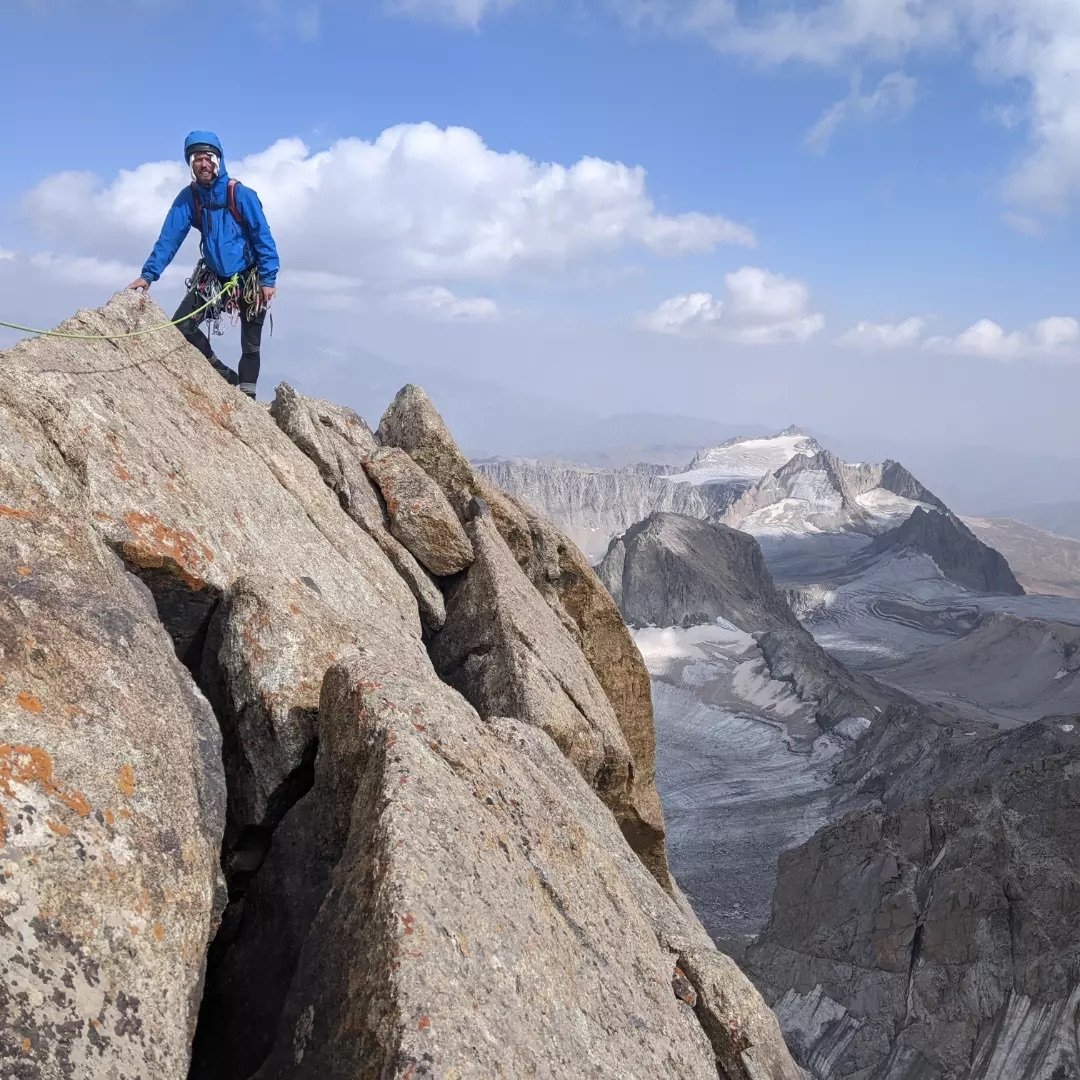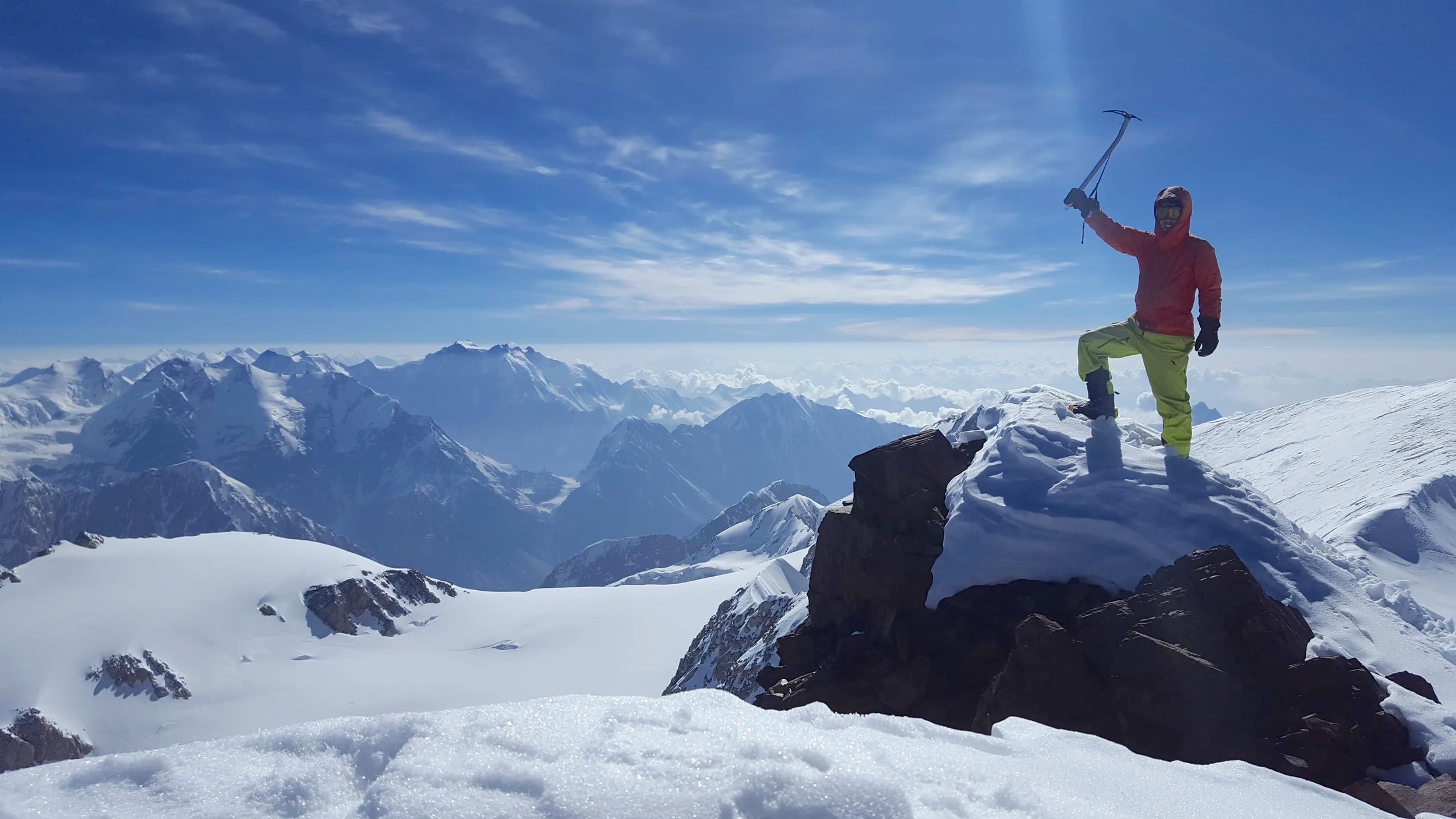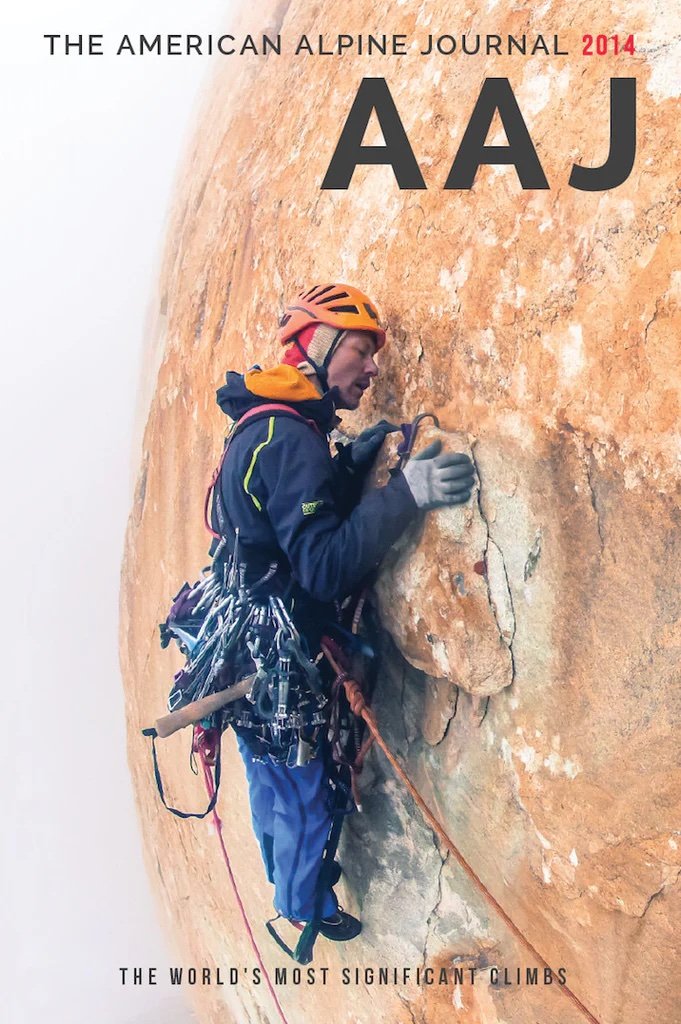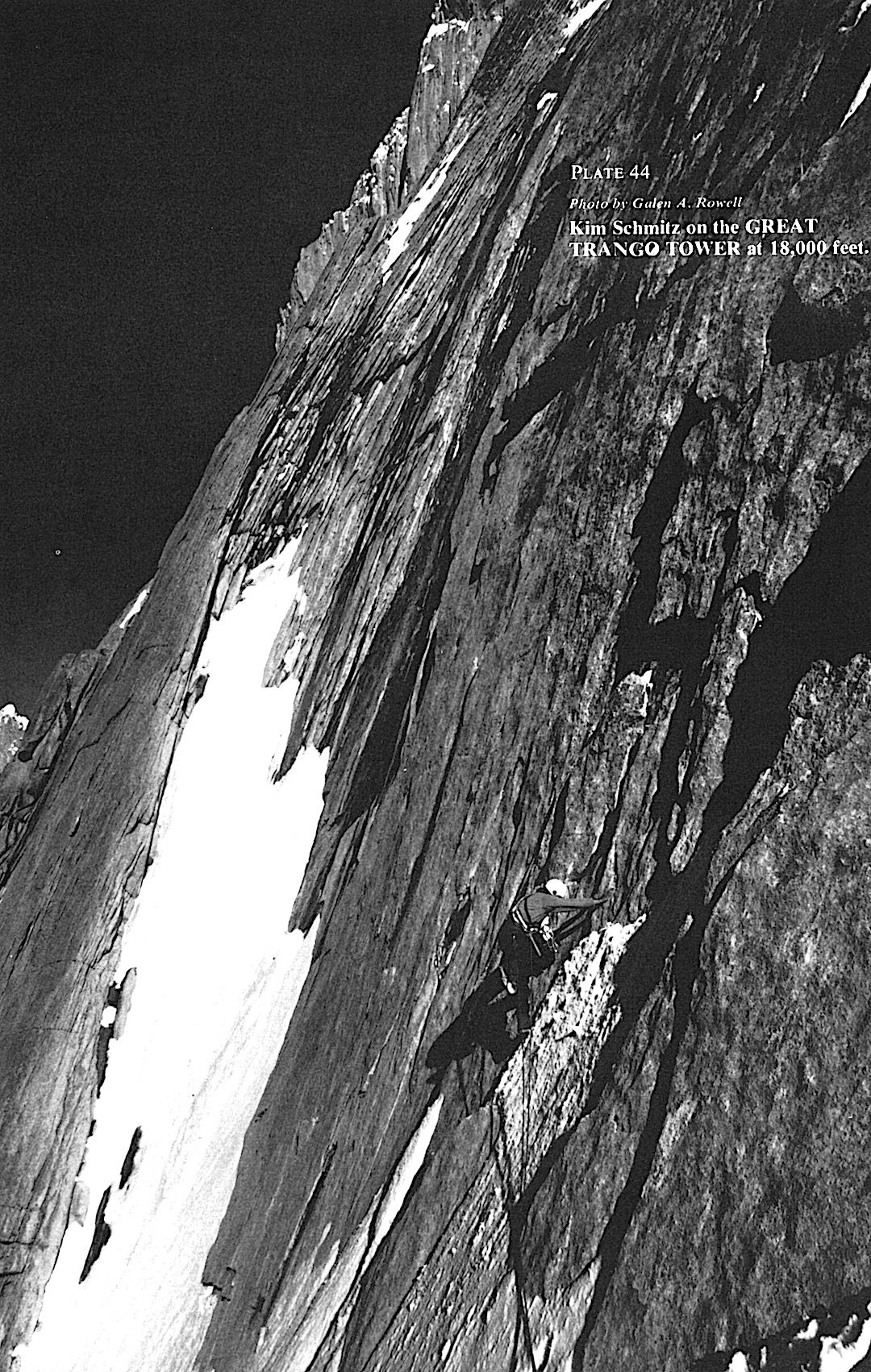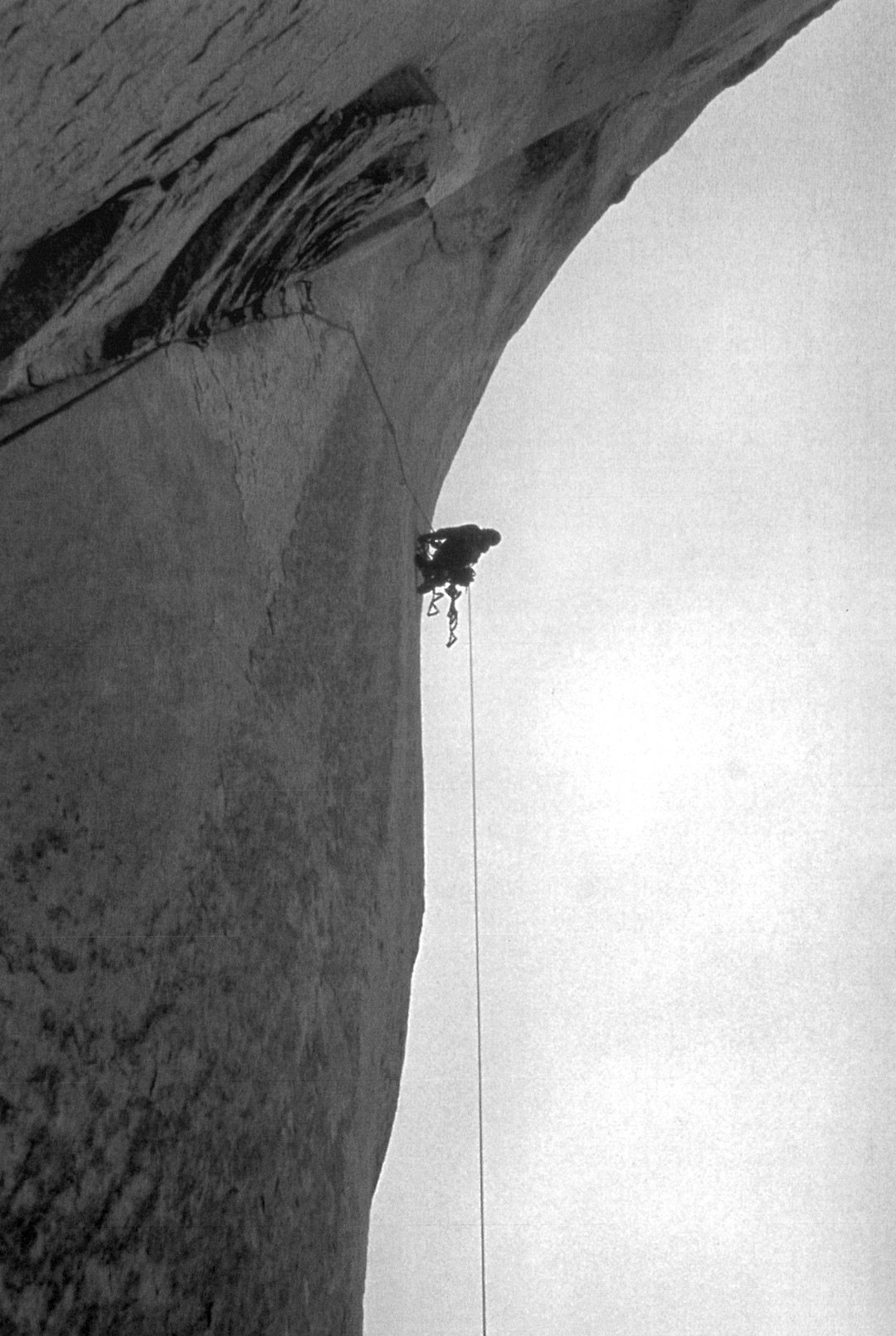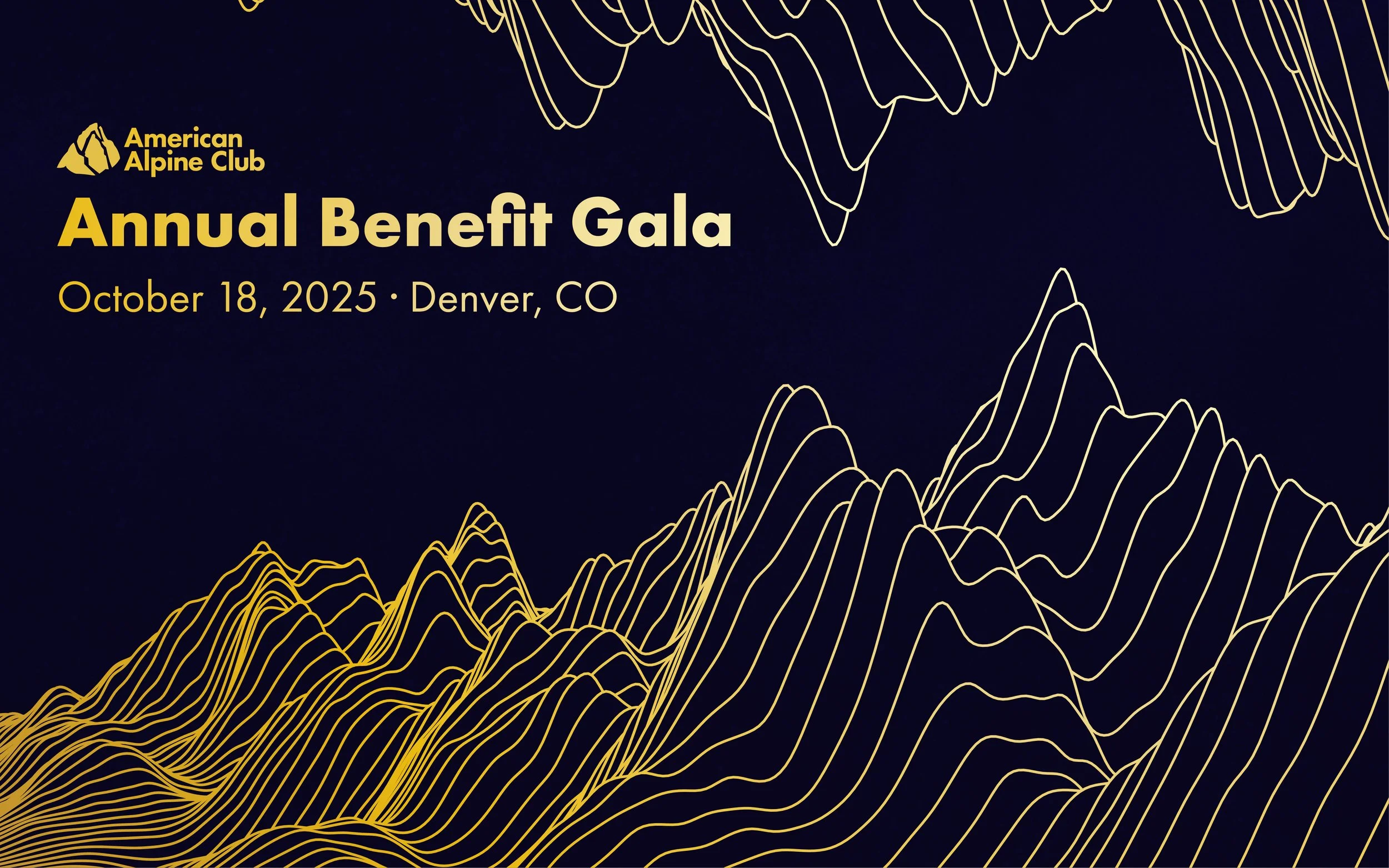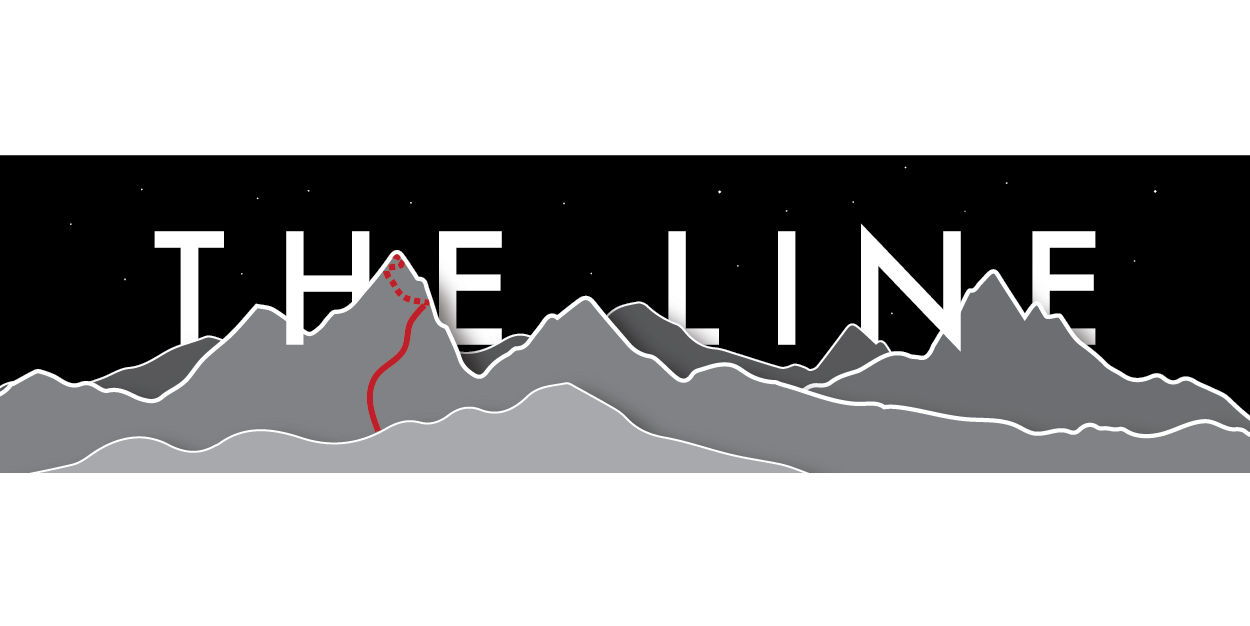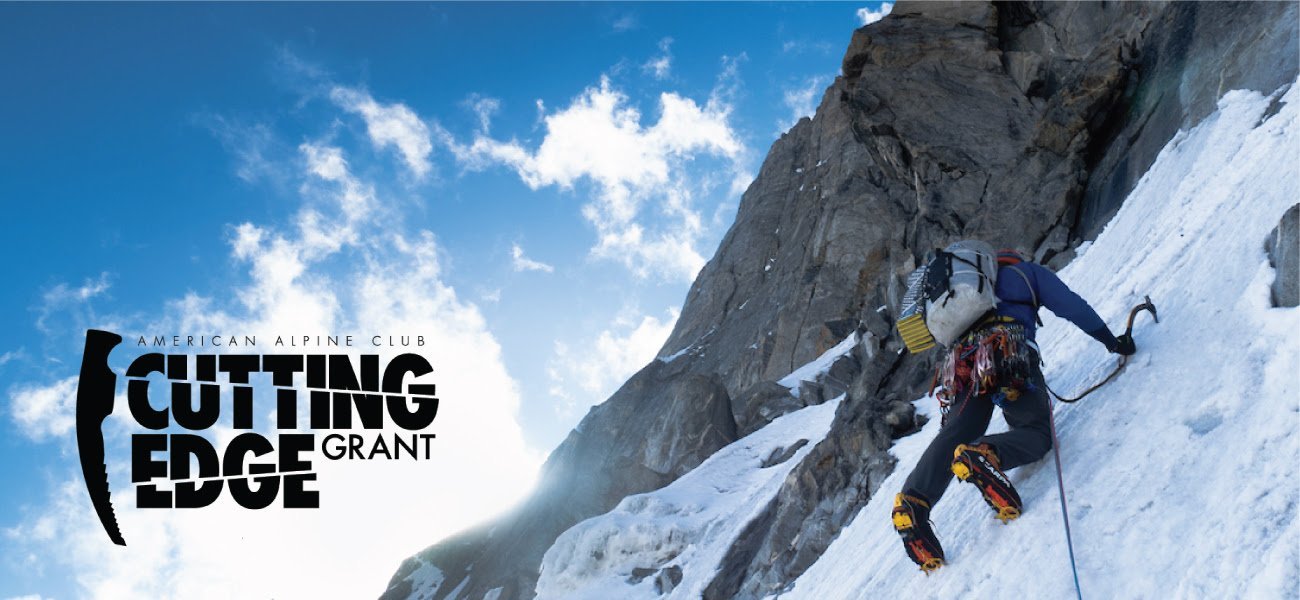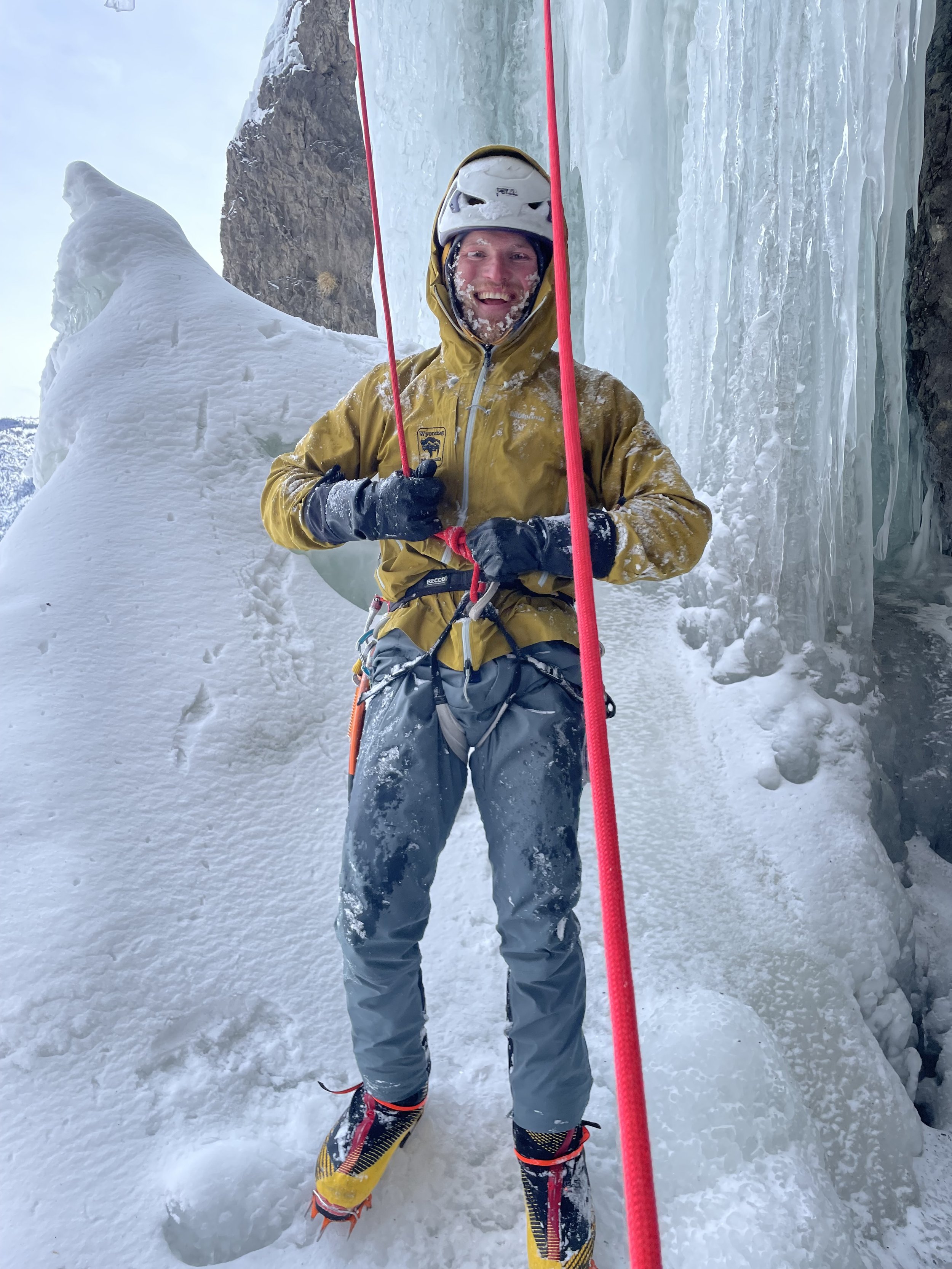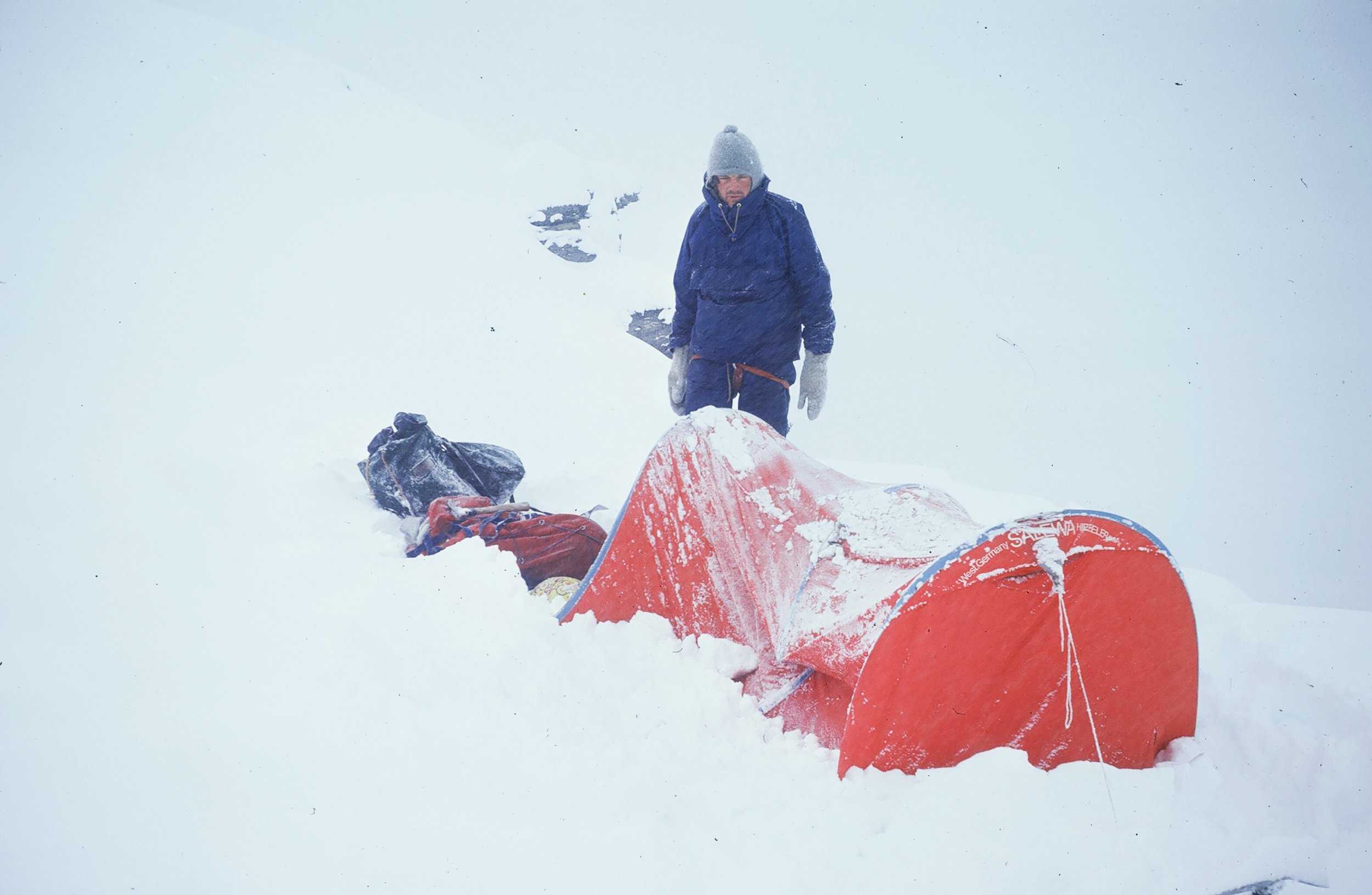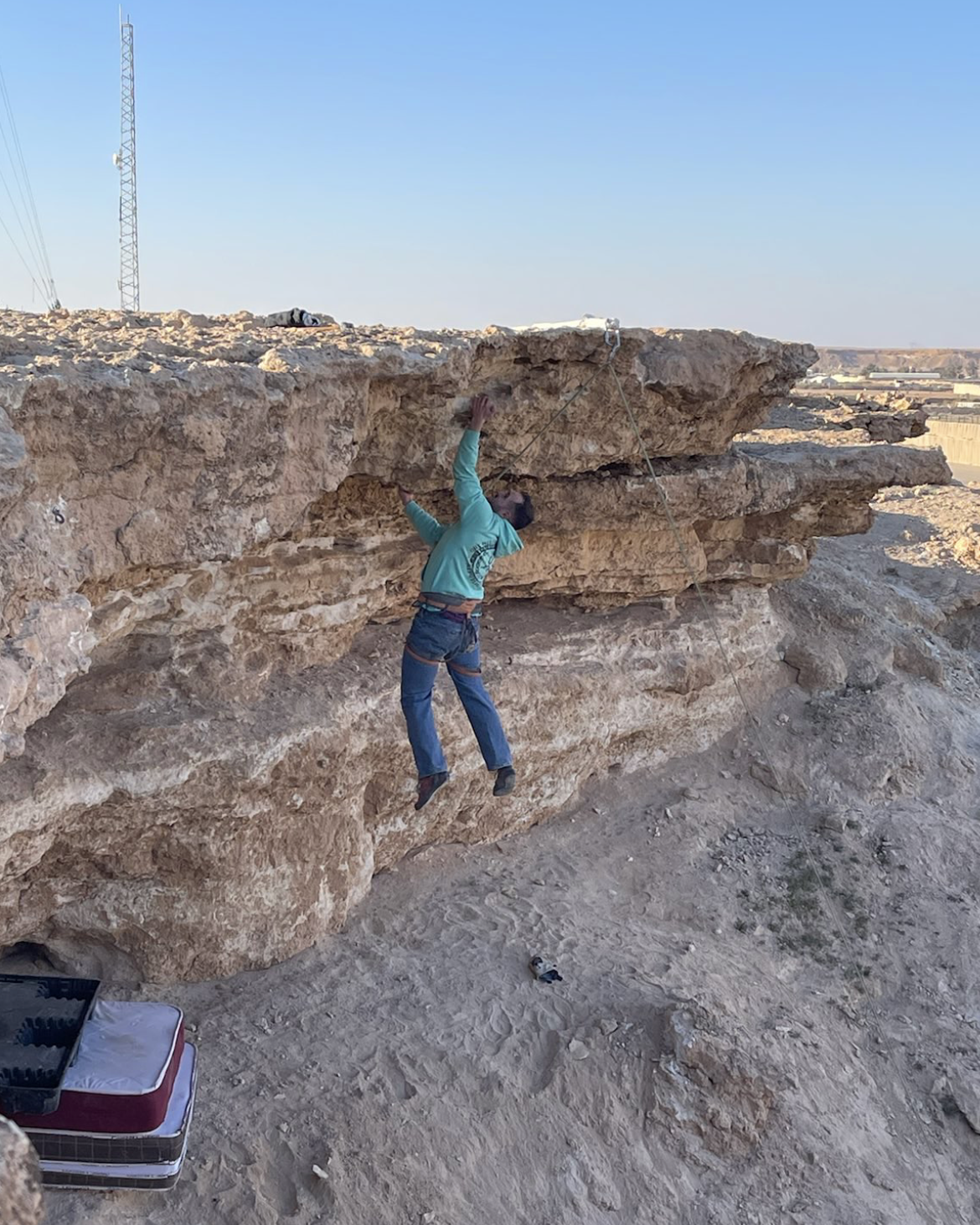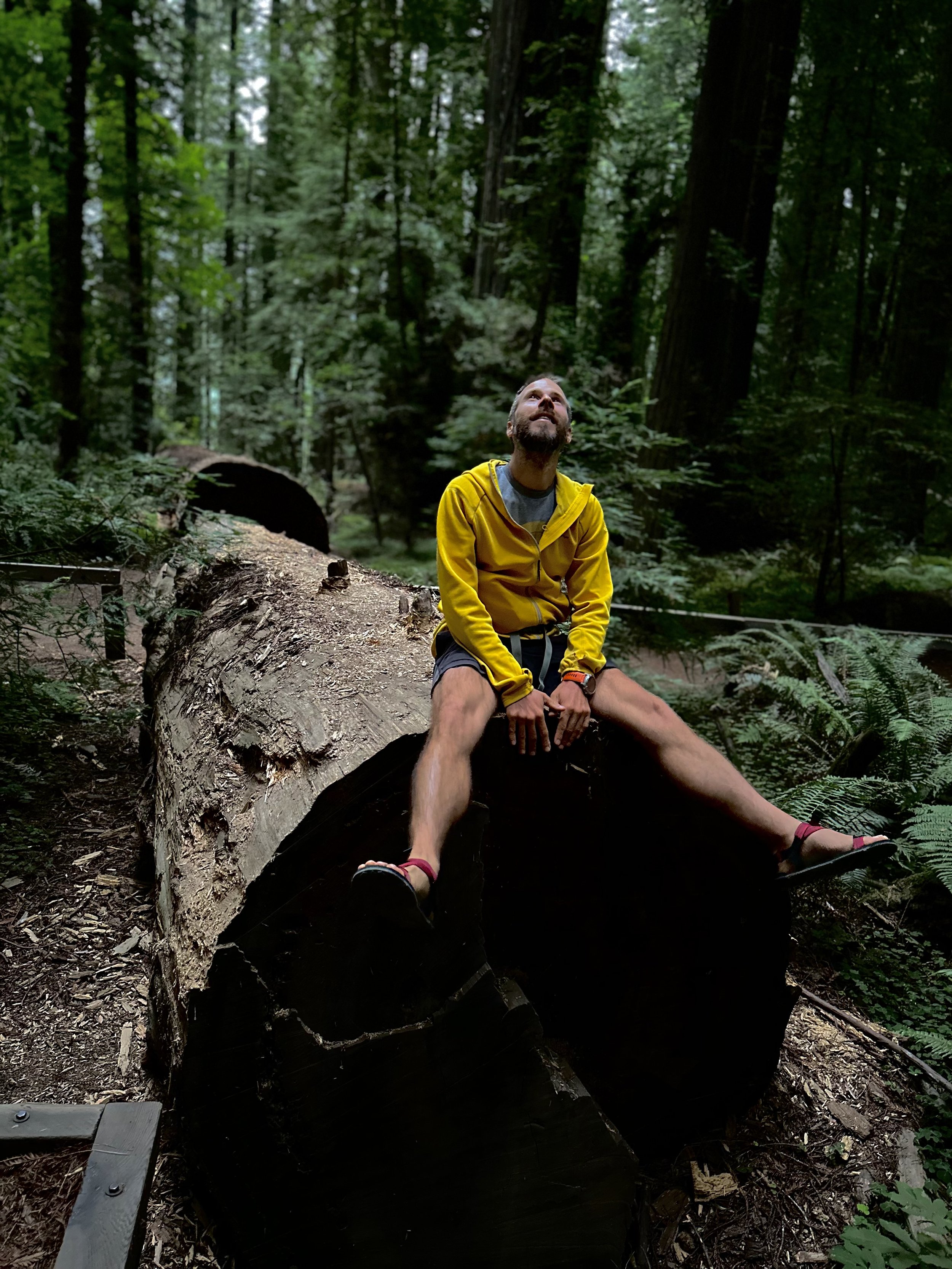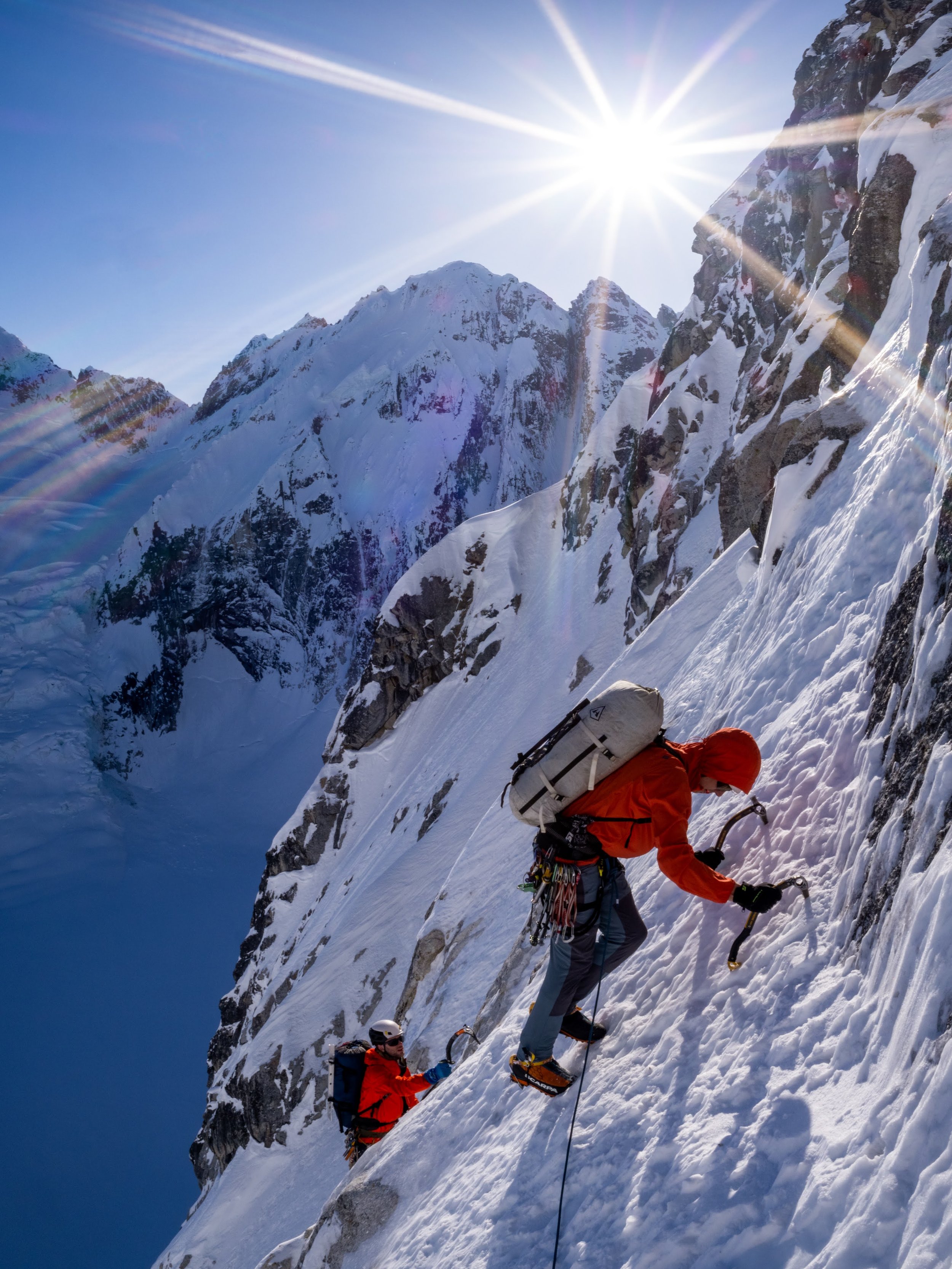On this episode of the Undercover Crusher series, we have Connie Shang on the podcast to talk about her recent send of Spyfiction, a 5.14c in Mt. Charleston, Nevada. We discuss her projecting process, how she’s leveled up over the years, how she got so strong without training, what counts as a crusher in today’s climbing world and especially for women’s climbing, and plateaus on the moonboard. She also talks about her unique perspective on climbing-work balance, that perhaps more of us should consider utilizing! Love to hear about hard climbing, but want to hear from someone who’s a little more relatable than the pros? The Undercover Crushers series is here for your inspiration! Dive in!
A Tribute to Michael Gardner
Michael Gardner astride the Infinite Spur on Sultana (Mt. Foraker) during a climb-and-ski adventure. Photo by Sam Hennessey. Originally published in AAJ 2022.
Michael Gardner
1991-2024
We are deeply saddened by the death of Michael Gardner: a great alpinist and a vibrant life.
Michael was on an expedition funded by the AAC’s Cutting Edge Grant, attempting the unclimbed north face of Jannu East in Nepal with his long time climbing partner Sam Hennessey, when he fell to his death on October 7th, 2024. We are grateful that Hennessey is safe after the incident.
There have been so many tributes to Mike in the last few days that attest to his incredible empathy, enthusiasm, dedication to the craft of climbing, pure motivations and lack of ego. Indeed, his quiet pursuit of the mountains on his own terms means his legacy is not flashy, but found in traces and in the background—he was climbing and skiing for the sake of the craft, not for recognition. Yet he was repeatedly the preferred partner for Cutting Edge Grant recipients like Hennessey, and his name appeared again and again in the American Alpine Journal over the last few years, for his new routes, fast ascents of iconic faces, and creative ski alpinism.
Rather than listing his great ascents here, and reducing him to a list of accomplishments, we encourage all who knew him, all who were inspired by him, to dive into the AAJ stories that feature him—as a way to walk, for a brief moment, alongside him in the memories of some of his greatest life experiences in the mountains. The mountains called him back again and again, whether it was to put up a new rock route on Mt. Owens, Renny Take the Wheel (1,500’, 8 pitches, IV 5.11), or envision the first ascent of Hot Cars and Fast Women (850m, M6+) with Hennessey on Denali’s Ridge of No Return. Mike and Sam were also simply fast. Their second ascent of Light Traveler (M7) on the southwest face of Denali in 2018 was not only the fastest for this route at the time, but for any of the four routes generally considered to be most difficult on Denali’s south and southwest faces: the Denali Diamond, McCartney-Roberts, Light Traveler, and Slovak Direct. In 2022, they upped the ante when they joined up with Rob Smith to climb the Slovak Direct in 17 hours and 10 min. In next year’s 2025 AAJ, his more recent mountain adventures will live on, testifying to the kind of life he shaped for himself, including a new route on Mt. Hunter, a massive ski link-up in the Tetons, and a new route on the Grand Teton.
Reading through these stories, you can see the creativity and quiet passion he brought to his climbing, and to his life.
Describing his conflicted relationship to the mountains in an article for Alpinist in 2022, Mike writes how, when he climbs: “An indescribable awareness of place and peace takes hold. On the other hand, there are consequences to devoting yourself to the mountains. I know them intimately, and yet year after year, death after death, I continue to climb.”
We can’t know if Mike would have thought it was all worth it. All we can do is honor the incredible void his death has left behind.
Our thoughts are with Michael’s family and climbing partners.
The Line — Mark Westman’s Long Quest to Climb Mt. Russell
Mark Westman has been climbing in the Alaska Range for nearly three decades and was a Denali Mountaineering Ranger for ten years. He has attempted Mt. Russell, on the southwest edge of Denali National Park, three times by three different routes over 27 years. The third time was the charm, as he and Sam Hennessey raced to the summit in a single day in late April. It was only the ninth ascent of the 11,670-foot peak, and Westman believes the line they followed may be the most reliable way to reach this elusive summit.
Sam Hennessey scales the rime wall just below the summit of Mt. Russell. Photo by Mark Westman.
Mt. Russell, East Face and South Ridge
At 9:45 a.m. on April 27, Paul Roderick dropped Sam Hennessey and me on the upper Dall Glacier, directly beneath the nearly 6,000-foot-tall east face of Mt. Russell—our objective.
We had in mind a rapid round trip. After quickly setting up a tent to stash food and bivouac gear, we departed half an hour after landing with light packs. We started up the left side of the east face, following the same line that Sam had climbed the previous spring with Courtney Kitchen and Lisa Van Sciver. On that attempt, they carried skis with the hope of descending off the summit. After 3,600 feet of snow and ice slopes, they reached the south ridge, which they found scoured down to unskiable hard ice. They retreated and skied back down to the Dall Glacier.
The route Sam and I followed on the east face steepened to 50° at about mid-height, and the snow we had been booting up gave way to sustained hard névé and occasional ice—much icier conditions than what Sam and partners had found at the same spot in 2023. We continued to a flat area at 9,600 feet, near the base of the upper south ridge of the mountain. Until this point, we had climbed unroped for most of the way.
The line of the Hennessey-Westman Route on the east face and south ridge of Mt. Russell. The first ascent (1962) reached the south ridge from the far side of the mountain. The direct south face and south ridge (2017) is at left, and the original east face (1989) and northeast ridge (1972) are on the right. Photo by Mark Westman.
The upper south ridge was the route followed by Mt. Russell’s first ascent team in 1962 (see AAJ 1963). They accessed it from the west side via an airplane landing on the Chedotlothna Glacier (which is no longer feasible because of glacial recession). This section of ridge was repeated by Dana Drummond and Freddie Wilkinson in 2017 after they pioneered a new route up the direct south face and south ridge of Russell (5,000’, AK Grade 4; see AAJ 2018).
A moderate section of the upper south ridge of Russell. Photo by Mark Westman.
From where we intersected the ridge, there were several tricky sections of traversing across 50° ice and knife-edge ridges. We used the rope for these parts, then continued unroped for several hundred feet, easily avoiding numerous crevasses. Just beneath the summit, we reached a near-vertical wall of rime ice, surrounded by fantastically rimed gargoyle formations that spoke to the ferocious winds that typically buffet this mountain. We belayed the short bulge of rime and minutes later became only the ninth team to reach the summit, just seven hours after leaving our landing site.
Nomenclature
The peak known today as Mt. Russell appears to have been called Todzolno' Hwdighelo' (literally “river mountain”) in the Upper Kuskokwim Athabascan language. This is according to a National Park Service–sponsored study of Indigenous place names written by James Kari, professor emeritus of linguistics at the University of Alaska. Today’s Mt. Russell was named for geologist Israel Cook Russell—one of founding members of the AAC. The California 14er Mt. Russell is also named for him.
There wasn’t a cloud in any direction and not a breath of wind. I had made storm-plagued attempts on Russell in two different decades, and there were many other seasons where I had partners and dates lined up but never left Talkeetna due to poor weather. It was truly gratifying to reach the top of this elusive summit.
Sam and I descended to the landing site in just four hours, making for an 11-hour round-trip climb and the mountain’s first one-day ascent. Paul picked us up the following morning.
While all of the terrain we followed had been climbed previously, the east face and south ridge had not been linked as a singular summit route. Having attempted the now very broken northeast ridge in 1997, and having climbed most of the Wilkinson-Drummond route in 2019, I feel confident the Hennessey-Westman (5,700’, UIAA V with 50° ice and 80°+ rime ice) is the fastest and most straightforward way to the summit of Mt. Russell. There is a perfectly flat bivouac site on the south ridge at approximately 9,600 feet, albeit very exposed to the wind. While the technical difficulties are modest, this route is sustained, serious, and committing.
Alaska Range Top Five
We asked Mark Westman, one of the most experienced modern climbers in Alaska, to name his five most memorable or personally important Alaska Range climbs. In chronological order, they are:
Mark Westman on the Infinite Spur of Sultana (Mt. Foraker) in 2001. Photo by Joe Puryear.
South Buttress (1954 Route), Denali, with the late Joe Puryear, April-May 1996. Significant for being my first time to reach the top of Denali, but also for being a month-long true wilderness adventure in total isolation on the mountain. It cemented my partnership with Joe for much bigger things that lay ahead.
Infinite Spur, Mt. Foraker, with Joe Puryear, June 2001. One of the most committing routes I ever did, and also the finest achievement I had with Joe after a decade-long climbing partnership that began when we were neophytes.
South Ridge of Mt. Hunter, with Forrest Murphy, June 2003. [It] had every sort of challenge one could expect in Alaska Range alpine climbing: difficult mixed and ice climbing, a serious icefall, a traverse of a high and massive mountain, extreme commitment, and, most of all, one of Alaska's most legendary corniced and knife-edged ridges (The Happy Cowboy), one of the most engaging mental exercises I have ever faced.
The Warrior’s Way, Mt. Grosvenor, with Eamonn Walsh, April 2006. How often does one get to make the very first ascent of a big face (the direct east face) on the west side of the Ruth Gorge? This was the last of three new routes we did on the peak (which were also the second, third, and fourth overall ascents), and it takes a king line straight up the middle of the face. Best of all, although run-out in places, it is relatively safe, and although technical, it goes at an approachable grade and has been repeated twice.
Denali Diamond, Denali, with Colin Haley, June 2007. This was a huge step up technically and stylistically for me, marking a multi-year transition from slower and heavier climbing to contemporary lighter and faster alpine-style techniques, with much credit to Colin for his youthful embrace of these methods. Managing this 8,000-foot-plus face in just 45 hours was a step well beyond what I would have imagined possible for myself many years earlier, and it was one of those rare climbs where literally everything goes as perfectly as you planned it back home in the living room.
A Place Among Giants
Lisa Roderick, Westman’s wife (and pilot Paul Roderick’s sister), was the base camp manager on the Kahiltna Glacier for more than two decades. (She attempted Russell with Westman and the late Joe Puryear in the late ’90s.) In early November, her memoir of nearly four years of cumulative time spent on the glacier, shepherding planes and climbers in and out of Denali base camp, will be published: A Place Among Giants: 22 Seasons at Denali Basecamp.
The Line is the newsletter of the American Alpine Journal (AAJ), emailed to more than 80,000 climbers each month. Find the archive of past editions here. Interested in supporting this publication? Contact Heidi McDowell for opportunities. Got a potential story for the AAJ? Email us: aaj@americanalpineclub.org.
Sign Up for AAC Emails
The Line: Global Ambition
Read how a professor of mechanical engineering at Seattle University solved a geographic mystery in Uzbekistan and made the first known ascent of that nation’s highest peak. (This same peak was also No. 141 in the professor’s quest to summit the high point of every country in the world.) Plus: attempting Everest, climbing Kangchenjunga, completing the “Seven ’Stans,” and becoming a Snow Leopard—just a few recent accomplishments in the very busy life of Eric Gilbertson.
Nearing the summit of Alpomish. Photo: Eric Gilbertson.
The following is adapted from a report by Eric Gilbertson for AAJ 2024.
Alpomish:
The First Ascent
Until recently, it was widely accepted that a broad, rocky 4,643-meter mountain in the Gissar Range, on the Uzbekistan-Tajikistan border, was the highest peak in Uzbekistan. This was based on the 1981 Soviet topographic map, the most accurate and recent map of the area. (In recent times, some online sources have called this mountain Khazret Sultan, but this is incorrect.) While researching Peak 4,643, possibly first climbed by Soviets in the 1960s, I realized that a border peak about six kilometers to the south, known as Alpomish, was potentially taller than Peak 4,643. Andreas Frydensberg (Denmark) and I laid plans to carry a differential GPS unit and sight levels to both summits and determine which was higher.
Acclimatized from ascents of Pik Korzhenevsky (7,105m) and Pik Ismoil Somoni (Pik Communism, 7,495m) in Tajikistan, Andreas and I headed to the Uzbekistan border region, and on August 21 we started our approach from Sarytag village. We hiked southwest alongside the Dikondara River, cached a few days of food, and continued south over several glaciated 4,000-meter passes and many talus fields, around 23 kilometers in total. Our base camp was by an unnamed glacier below the steep east face of Alpomish.
The first known ascent of Alpomish, by the east face (5.8). The rock wall is about 400 meters high. Photo: Eric Gilbertson.
The four-spired peak loomed above camp with 400-meter granite faces on each spire. The southernmost spire looked to be the tallest, which I verified with sight levels.
On August 23, we hiked to the east face and scrambled up a big gully on scree until it was blocked by a huge chockstone. I led a rock face then traversed left delicately to reach the top of the chockstone. Above a waterfall in the gully, ice continued all the way up to the notch, and since we’d left our ice gear below, we climbed the rock wall and ridge crest to the left. Once on the gendarmed summit ridge, a final knife-edge brought us to the top.
Using the sight levels, I first verified that all the nearby spires of the peak were shorter—we were definitely on the highest point of Alpomish. I set up the differential GPS, but it had trouble acquiring satellites. So I pointed my sight levels toward Peak 4,643, and with each level measured 10min–20min angular declination looking down at the distant summit. Clearly it was lower. There were no anchors, cairns, or any sign of human passage anywhere on Alpomish, so it seemed very likely we had made the first ascent. Our measurements showed that Alpomish is 25 meters (+/-8 meters) higher than Peak 4,643, giving an elevation for Alpomish of around 4,668 meters.
Gilbertson and Frydensberg on the summit of Alpomish. Photo: Eric Gilbertson.
After rappelling and downclimbing, we staggered back into camp shortly before midnight. Our route was the Upper East Face (300m, 5.8).
To be absolutely certain about the relative elevations, I wanted to take measurements from the top of Peak 4,643, looking back to Alpomish, so the next day we retraced our route over the glaciated passes, picked up our food cache, and hiked to the base of Peak 4,643.
On August 25, we climbed the northeast ridge, with long stretches of 4th-class scrambling on a knife-edge and two pitches of 5.7. On the summit, I used sight levels to measure the angular inclination up to Alpomish. All six measurements showed that Alpomish is higher than Peak 4,643, making it the highest point in Uzbekistan.
Andreas Frydensberg on top of Noshaq, the 7,492-meter high point of Afghanistan, in July 2019, two years before the Taliban takeover of the country. Photo: Eric Gilbertson.
The Seven ’Stans
Breaking trail up massive Pobeda, the highest summit in Kyrgyzstan. Photo: Eric Gilbertson.
Eric Gilbertson and Andreas Frydensberg’s climb of Alpomish was part of a four-year effort to reach the highest point of all seven nations whose names end with “stan.” Most of these were very challenging mountaineering objectives.
In 2019, they climbed Noshaq (7,492m, Afghanistan). In 2021, they tagged the summits of Khan Tengri (7,010m, Kazakhstan) and Pobeda (7,439m, Kyrgyzstan). In 2022, it was K2 (8,611m, Pakistan), without supplementary oxygen. And in 2023 they climbed Ismoil Somoni (7,495m, Tajikistan), Ayrybaba (3,139m, Turkmenistan), and Alpomish (ca 4,668m, Uzbekistan). Gilbertson reported that Pobeda (via the Abalakov Route) was technically and physically the most difficult of the seven (technical climbing at high altitude with no fixed ropes, deep snow, serious objective and frostbite danger) and that Noshaq was logistically the toughest (landmines and kidnapping hazards).
EVEREST & KANGCHENJUNGA
As if climbing two 7,000-meter peaks in Asia last summer weren’t enough, Eric Gilbertson also made a strong attempt on Everest in May (reaching 8,500 meters without supplementary oxygen or personal Sherpa support). He then flew to Kangchenjunga and summited the world’s third-highest peak, thus ticking the high point of India on his list.
Gilbertson, along with his twin brother, Matthew, ultimately hope to reach the high point of every country in the world, a project that started in 2010. As of this month, Eric has climbed 143 of 196 the world’s high points. See the Country Highpoints website for his extensive trip reports.
Having climbed the five 7,000-meter peaks of the former Soviet Union, Gilbertson and Frydensberg applied to be named Snow Leopards, a great honor of Russian mountaineering. In November 2023, Gilbertson became the third American Snow Leopard (after William Garner and Randy Starrett in 1985) and Frydensberg the first Dane, but not without proving their case: The authorities argued that they had climbed the wrong summit of Pobeda. Gilbertson embarked on another geographic investigation and soon settled the matter. The results are documented in The True Summit Location of Peak Pobeda.
How Does He Do It?
How does a 38-year-old assistant professor have the free time and spare cash to complete so many international expeditions? Gilbertson explains:
”I'm a teaching professor at Seattle University. This means I get about three months off every summer for mountaineering, and also winter and spring breaks between quarters. Sometimes I can get permission to overload my teaching schedule in a few quarters and take another quarter off. This was important for a peak like Kangchenjunga, which needs to be climbed in spring.“ As graduate students, Gilbertson and his brother, Matthew, were invited to international engineering conferences, which they paired with climbs.
“I try to be as frugal as possible,” he said. “Most of the European country high points I climbed as part of long-distance bicycle tours, camping in the woods every night, so transportation and lodging were basically free. I generally don’t pay for guides unless required by law. I sign up for airline credit cards to get free flights.” Gilbertson and his partners also maximize their efficiency and success rate during expeditions by paying for custom, satellite-delivered weather forecasts from Denver meteorologist Chris Tomer.
For Everest, Gilbertson hired the relatively inexpensive Seven Summit Treks (SST) for logistics and base camp services, then he climbed on his own above BC and did not pay for oxygen service (the same way he climbed K2 in 2022). As he was shopping for a guiding service, he negotiated for a multi-summit and multi-climber discount.
As events turned out, SST required Gilbertson to hire a Sherpa and use oxygen for his rapid Kangchenjunga ascent after Everest. “It would cost another $11K…and I could just barely afford that if I zeroed out my bank account,” Gilbertson wrote in his trip report. “That would be cheaper than losing all the money I’d already invested and then paying more a future year to come back. So I reluctantly agreed.”
The Line is the newsletter of the American Alpine Journal (AAJ), emailed to more than 80,000 climbers each month. Find the archive of past editions here. Interested in supporting this publication? Contact Heidi McDowell for opportunities. Got a potential story for the AAJ? Email us: aaj@americanalpineclub.org.
The Line — July 2024
AMERICA THE BEAUTIFUL
It’s prime season for climbing in the high peaks of the western United States, so we’re sharing six brand-new mountain routes from six states around the West.
AAC Members: Get a Sneak Preview of the AAJ right now! AAC members can now download a PDF of the complete 2024 AAJ. Log in at your member profile and click the Publications tab to download your sneak preview. Physical copies of the 2024 AAJ will start going into the mail next month.
Bluebell (Cascade Range, Washington)
The line of Bluebell (21 pitches, 5.13-) on the North Norwegian Buttress of Mt. Index. Photo by Nathan Hadley.
Nathan Hadley and friends spent more than 25 days establishing and free climbing Bluebell (2,000’, 5.13-), the first free route up the North Norwegian Buttress of Mt. Index. About one-third of the bolt-protected route’s 21pitches are overhanging. Hadley believes it’s one of the steepest long free climbs in North America (“Imagine two of Yosemite’s Leaning Towers, with sections of slab before, in between, and after.”) Hadley’s AAJ report describes the arduous effort to establish the climb and also offers a touching tribute to one of his partners on the route: Michal Rynkiewicz, who died in a rappelling accident soon after this climb was completed.
Aiguille Extra (Sierra Nevada, California)
James Holland following the second pitch (5.10+) of the new direct start to the East Buttress of Aiguille Extra. Photo by Cam Smith.
The East Buttress of Aiguille Extra, a 14,048-foot satellite of Mt. Whitney, was first climbed in 1978 with a bit of aid. Forty-five years later, James Holland and Cam Smith freed the 10-pitch route at 5.10+, adding a three-pitch direct start. In AAJ 2024, Smith writes, “James and I hope the free version of the East Buttress (1,230’, IV 5.10+) will encourage others to check out [Aiguille Extra], an unsung gem of the Eastern Sierra.”
Takin’ ’Er by the Tusks (Sawtooth Mountains, Idaho)
Benj Wollant finishes the crux sequence of pitch three (5.12a R) on Takin’ ’er by the Tusks. Photo by Greg Rickenbacker.
A rare new route up the beautiful Elephant’s Perch was completed in September by Greg Rickenbacker and Benj Wollant. Takin’ ’Er By the Tusks (625’, 5.12a R A3) combines challenging aid and stout free climbing on the southeast face of the granite formation. A bolting ban in Sawtooth National Forest ensured plenty of exciting climbing. Wollant, who grew up in the nearby town of Stanley, wrote in his AAJ report that establishing a route on the Elephant’s Perch was “a longtime dream come true.”
Spirit Animal (Rocky Mountains, Colorado)
The line of Spirit Animal on the 1,500-foot northeast face of Chiefs Head in Rocky Mountain National Park. Photo by Bill Duncan.
“Given that I’d never stepped foot into Glacier Gorge [in Rocky Mountain National Park], you might say my plan to rope-solo a new line up the 1,500’ northeast face of Chiefs Head (13,577’) was ambitious,” writes Nathan Brown in AAJ 2024. But that’s what he did. Brown, a prolific new-router who earned his ground-up chops in North Carolina before moving to Colorado, spent two summers establishing Spirit Animal (10 pitches, 5.11), all alone, on the remote and steep Chiefs Head wall. Brown finished work on the route last September, but had not yet redpointed the full route in a continuous ascent. Just this month, he made the trek into Glacier Gorge yet again and rope-soloed the route completely free, with a bivouac in the middle.
Directissima (Mt. Owen, Teton Range, Wyoming)
(A) The Grand Teton. (B) Mt. Owen. (1) The original North Ridge Route (1951). (2) Directissima (2023). Both routes continue up the long ridge to the summit of Mt. Owen. However, the FULL north ridge, continuing over Mt. Owen and up the north ridge of the Grand, may never have been linked. Photo by Acroterion | Wikimedia.
Tetons guide Michael Abbey had long imagined a more direct route up the north ridge of Mt. Owen, hewing closer to the ridgeline than the original North Ridge Route (Clayton-Emerson, 1951), which slants in from the left. It took a couple of attempts, but in 2023 he and Karen Kovaka completed Directissima (V 5.10) over two days in August. In his AAJ report, Abbey notes that another North Ridge Direct was climbed in 2001, but the key pitches of the new line were most likely unclimbed before last summer.
Ménage Trout (Beartooth Mountains, Montana)
Jackson Marvell climbing the sixth pitch of Ménage Trout, high above East Rosebud Creek in the Beartooth Mountains. Photo by Austin Schmitz.
Until 2023, the Bear’s Face had only one known full-length route: Ursus Horribilis, established in 1998 by Andrew McLean and the late Alex Lowe. Last summer, Chantel Astorga, Matt Cornell, and Jackson Marvell, along with photographer Austin Schmitz who was shooting images of The North Face team members, completed a line started by Cornell, Marvell, and Justin Willis three years earlier. Ménage Trout has 13 pitches and went at 5.10+ R A2+. Astorga wrote in her AAJ report that the team hopes to return to free the climb.
Bear’s Face also got its first winter ascent in 2023, when Adrien Costa, Charlie Faust, and Paul Shaughnessy completed Dancing Bears (310m, WI5 M6 R) on the left side of the face, on the last day of the year, after multiple attempts.
Explore These Peaks
Take a closer look at all six of the peaks and ranges highlighted here with this interactive map from onX and Mountain Project.
The Line is the newsletter of the American Alpine Journal (AAJ), emailed to more than 80,000 climbers each month. Find the archive of past editions here. Interested in supporting this publication? Contact Heidi McDowell for opportunities. Got a potential story for the AAJ? Email us: aaj@americanalpineclub.org.
The Line is supported by:
Educate: Search and Rescue Helicopter Evacuation in the Black Canyon of the Gunnison
Photo by AAC member Jon Glassberg.
This year, the featured winner of the Rocky Talkie Search and Rescue Award is the Black Canyon Search and Rescue team, who performed an incredibly technical rescue in 2023 in the Black Canyon, after a climber took a bad fall that left them unconscious, needing medical attention almost 2,000 ft down into the canyon. In this episode, we sit down to chat with Sean Hart, one of the SAR team members at the scene that day, who walks us through the unique challenges of climbing and rescuing in The Black, the harrowing rescue by Blackhawk helicopter, how critical communication is in rescues, and how to always have a plan B.
Learn more about the Rocky Talkie Search and Rescue Award, watch the film about this incredible rescue, and get the chance to give back to your local search and rescue team AND win some incredible gear by going to https://rockytalkie.com/pages/sar-award
Announcing the 2024 Rocky Talkie Search & Rescue Award Winners
We’re thrilled to partner with Rocky Talkie to announce the winners of the 2024 Search & Rescue Award. Through this grant, Rocky Talkie is donating $75,000 to six underfunded SAR teams across the nation. Read their stories and watch a film by Jon Glassberg about the Featured Rescue of the Year on Rocky Talkie’s website.
You can also enter to win $5,000 for your local Search and Rescue team plus a safety prize package for yourself through Rocky Talkie’s SAR Award giveaway when you visit their website.
Must-Read Ascents On Great Trango Tower From The American Alpine Journal
By: Sierra McGivney
A wonderful panorama looking southeast over Great Trango Tower from the summit of Trango II. (A) K7 (6,934m). (B) Yermanendu Kangri (7,163m). (C) Masherbrum (7,821m). (D) Mandu East (7,127m). (E) Mandu West (7,081m). (F) Urdukas (6,320m). (G) Seemingly unnamed. (H) Liligo Glacier. (I) Great Trango northeast (6,231m). (J) Great Trango Main (6,286m). (K) Great Trango southwest (ca 6,250m). (1) Great Trango normal route. (2) Top section of Krasnoyarsk Route. The lower left foreground is the summit of Trango Tower. PC: Jakob Schweighofer
"The impressive rock spires of Great Trango Tower and Trango (a.k.a. Nameless) Tower create one of the wonders of the Earth, capturing the imagination of everyone who travels on the Baltoro Glacier. Great Trango resembles a giant castle flanked by steep walls. On top of nearly a mile of sheer rock, four magnificent summit turrets comprise the East, West, Main (middle), and South summits," writes John Middendorf.
Great Trango Tower is located in the Baltoro Glacier region of the Karakoram Range of Pakistan. The Karakoram is located mostly in northern Pakistan but also reaches into Tajikistan, China, Afghanistan, and India, creating a diverse ecosystem. Cutting-edge alpinists travel to the area to test their skills by climbing new routes on some of the biggest walls in the world. Great Trango Tower, which sits at 6,286 meters, offers challenging granite face-climbing and unforgettable rock features. The climbing history of the mountain runs deep, so we have compiled a list of must-read ascents on Great Trango Tower from the AAJ.
Don't worry! We haven't forgotten Trango Tower (AKA Nameless Tower), the other famous monolith in the Trango Towers group. Our next dive into the AAJ archives will focus on the legendary ascents on Nameless Tower, so be on the lookout. Until then, dive into these epic stories from Great Trango Tower.
1. The First Ascent of Great Trango Tower
Great Trango Tower. Climb Year: 1977. Publication Year: 1978. Author: Dennis Hennek.
Kim Schmitz on perfect granite at 18,000 feet on the Great Trango Tower. Photo by Galen A. Rowell.
This list wouldn't be complete without the first ascent of Great Trango Tower. After rerouted and canceled flights, Galen Rowell, John Roskelley, Kim Schmitz, Dennis Hennek, and Dr. Lou Buscaglia began their trek through the Shigar Valley up the Braldu River Valley, where they met up with the final member of their team, Dr. Jim Morrissey. Once they established basecamp on Trango Glacier, a four-day storm settled over them, causing debris to fall on their proposed climb.
Telephoto view of Gasherbrum IV and Hidden Peak over Baltoro Glacier from the summit of Great Trango Tower. Photo by Galen A. Rowell.
"The scene greeting us at the base of the gully brought us back to reality and the seriousness of the next 3,500 feet."
On the first day of climbing, Hennek, Rowell, Schmitz, and Roskelley witnessed an avalanche filling the gully they had just ascended, where they believed Buscaglia and Morrissey to be. But "luck stayed with us"— the two had scrambled to the side of the gully to check out a waterfall, the avalanche narrowly missing them. This was only the first day, and it wouldn't be the only hurdle in their journey. Yet the rewards were great. "The afternoon was warm and clear, with an unobstructed, unforgettable view in all directions. We all agreed that there could be no better view of the Baltoro Karakoram." Read about the first ascent while looking at black and white photos from their expedition here.

2. Suffer Well: Thirst and Hunger On The Azeem Ridge
Great Trango, Pakistan. Publication Year: 2005. Author: Kelly Cordes.
The cover of AAJ 2005: Josh Wharton traversing (5.10+ A1) into the headwall on day 3, about 1,500m up the Azeem Ridge, Great Trango, Pakistan. Photo by Kelly Cordes.
This article stands out in the AAJ archives because of what a saga this ascent turned out to be. Josh Wharton and Kelly Cordes climbed Great Trango’s southwest ridge, which they called the Azeem Ridge (7,400' vertical, 5.11R/X A2 M6), in what they deemed "delusional optimism," "disaster style," and "safety fifth!" climbing. Cordes and Wharton climbed 54 pitches, facing many challenges. On the second pitch, one side of their jury-rigged double-gear slings came undone, causing about a quarter of their cams to fall. Then, halfway up the wall, the two ran out of fuel, leaving them with only one option, sucking on snow in place of drinking water. Cordes wrote: "When we reached the bivouac where our last fuel sputtered out, we never spoke of retreat." On the fourth morning, Wharton's headlamp slingshotted out of his hands and was lost to the tower. Soon after, Cordes’ belay device suffered the same fate. At this point, their only option was up and over. Continue reading about how Cordes and Wharton kept heading up, even against all odds.
3. Climbers vs. Technology
Great Trango Tower's Northwest Face. Publication Year: 2000. Author: Jared Ogden.
Alex Lowe and Mark Synnott with computers at Camp I. Photo by Jared Ogden.
This article was written at the turn of the century when technology and climbing began to clash. Jared Ogden, Mark Synnott, and Alex Lowe faced moral dilemmas about filming and hosting a live internet site during the expedition for their sponsor, Quokka Sports Inc. Quokka.com was one of the only virtual adventure sports websites near the dawn of the internet, until they went bankrupt in the spring of 2001. Ogden, Synnott, and Lowe brought "all assortments of cyberspace technology," including computers and video cameras, and fixed more than 3,000 feet of rope. Foreshadowing today's day and age of viral climbing videos on TikTok and Instagram, this article launched a discussion of technology and its place in climbing. But once on the wall, the team's technology worries disappeared, and they became engrossed in the ethereal alpine world of the Karakoram.
Alex Lowe Cleaning Pitch 30. Photo by Jared Ogden.
The team faced challenges with group dynamics, fever, and "storm-ridden suffer-fests." Through hard-earned adventure, the team produced Parallel Worlds (VII 5.11 A4, 6,000'). "Our…route combined all the elements of rock climbing: a long free climb up a 3,400-foot slab to a vertical and overhanging headwall that stretches over 2,000 feet, finishing on a knife-edge ridge for 1,000 feet to the West Summit," wrote Ogden. Read about this harrowing adventure and Ogden's tribute to Alex Lowe, who died in an avalanche just a few months after this climb.
Want to read more discourse about technology and its place in the mountains? Read Steve House's hot take on "business climbing" and media regarding the ascent of Parallel Worlds here.
4. The Russian Way
Author: Yuri Koshelenko, Russia. Publication Year: 2000.
Parallel worlds: the American (left) and Russian teams hard at work on the headwall pitches on Great Trango's northwest face. Photo by Yuri Koshelenko.
While Jared Ogden, Mark Synnott, and Alex Lowe were putting up Parallel Worlds, Yuri Koshelenko, Alexander Odintsov, Ivan Samoilenko, and Igor Potankina climbed a line to the right of them—parallel up the Northwest Face of Great Trango Tower. The two groups worked hard next to each other for a time, developing genuine mutual assistance, "I was unexpectedly seized by the warm hospitality of the American team. I took huge gulps of piping hot tea from Alex's cup while thinking about the condition of the wet rock," writes Koshelenko. On July 24, after ascending shared fixed ropes, the two groups split apart, and so began the Russian team's arduous journey up dangerous 5.10 to 5.11 free climbing and difficult A3 and A4 sections. Two days later, while climbing a roof, Odintsov ripped off a huge block, tumbling down the face, caught by a well-placed cam but suffering hip and shoulder injuries. Odintsov's fall was just the beginning of their intense battle up the wall. The group faced unstable weather, including snowstorms, multiple uncomfortably close lightning strikes, a dropped haul bag, and dwindling food supplies. Read the epic tale of the ascent of The Russian Way (VII 5.11 A4, 2675m), written beautifully by Yuri Koshelenko, here.
"The mountains always accept the tribute, though sometimes the price may seem excessive. But humanity cannot exist without extremes—such is the law of evolution."
5. Epic Attempts on the Trango Towers
Great Trango Tower and Trango Nameless Tower, Attempts. Publication Year: 2001. Author: Timmy O'Neill
Funded by the American Alpine Club's Lyman Spitzer Climbing Grant, now the Cutting Edge Grant, this trip report chronicles two attempts of the southwest ridge of Great Trango, now the Azeem Ridge, by Timmy O'Neill and Miles Smart. O'Neill and Smart spent almost 50 days on the Trango Glacier waiting out bad weather. During one of their three brief weather windows, they attempted the southwest ridge of Great Trango, an effort "ended with a forced bivy at 18,000" after climbing for 12 hours through 4,000 feet of 4th class to 5.10. They tried again to no avail, despite climbing to within 300 meters of the summit, and moved on to a potential ascent of Eternal Flame on Nameless Tower. Their first attempt on Eternal Flame, "a one-day, single-push climb," ended with a difficult decision to descend six pitches from the summit. Three days later, they "blasted" from the col, ready to summit Eternal Flame. After eight hours of climbing, "the hand of Allah came to catch me and then subsequently thwack me into the wall," writes O'Neill. O'Neill had fallen 100 feet after he short-fixed his rope. Read about the epic attempts on the Trango Towers here.
6. Triumph and Tragedy on Great Trango Tower
The Norwegian Buttress, 1984.
In 1984, a Norwegian team of four, Hans Christian Doseth, Finn Daehli, Stein P. Aasheim, and Dag Kolsrud, attempted the first ascent of the East Face of Great Trango. Due to a lack of food and slow progress up the wall, the team decided to split. Aasheim and Kolsrud rappelled off safely, reaching the Dunge Glacier, while Daehli and Doseth continued on. From the ground, Aasheim and Kolsrud watched via telephoto lenses as their friends reached the summit. Tragically, Daehli and Doseth fell to their deaths during the descent. Their bodies were later spotted at the foot of the climb, but soon after, an avalanche buried them. Their magnificent line was named the Norwegian Buttress. "The triumph had turned into a total tragedy." Read more about the Norwegian Buttress in an article in the 2000 AAJ, which also describes another new route on Great Trango, the Norwegian Trango Pulpit Direct (VII A4 5.11, ca. 2200m).
7. The Grand Voyage
Great Trango Tower, East Face, Swiss-American Expedition, Second Ascent To The East Summit. Publication Year: 1993. Author: John Middendorf.
Xaver Bongard on Great Trango Tower. Photo by John Middendorf.
We picked this article because of the challenging climbing featured in it and because it was written by the one and only John Middendorf. The recent passing of John Middendorf deeply saddens us, and we invite you to read our tribute to him here.
The Grand Voyage (the Bongard-Middendorf route). This photo doesn’t show the 1984 Norwegian route, which climbed the same buttress, making the first ascent of Great Trango’s East Summit. Grand Voyage started far to the left of the Norwegian route, joined it for three pitches above the big midway ledge, and finished to the right of the Norwegian route. Photo by John Middendorf.
The Swiss-American Expedition, comprised of Swiss Xaver Bongard, Ueli Bühler, François Studiman, American photographer Ace Kvale, and John Middendorf, sought to establish a new line on the east face of Great Trango Tower: The Grand Voyage (Grade VII, 5.10, A4+), which started to the left of the original Norwegian Route and finished to the right. Bongard and Middendorf climbed capsule-style, moving their high camp upward and creating "safe havens" on the wall; they established five camps on the wall, four hanging and one at the snow ledge halfway up. This style of climbing resulted in almost a month on the wall. Ice, snow, and rock fall were high objective hazards for the group. In turn, this created belay stations that were "in suicidal positions." The group climbed the last five pitches below the snow ledge through vertical ice climbing, "rotten aid," and free climbing up a "dangerous steep corner system"—dubbed "Gollum's Gully"—at night due to high objective hazards. "Occasionally, huge sections would exfoliate off the wall and pound down around us." Continue reading about the legendary The Grand Voyage (Grade VII, 5.10, A4+) here.
8. Pitch by Pitch, Move by Move: The Other Side of The Grand Voyage
Great Trango Tower. Publication Year: 1995. Author: Xaver Bongard, Club Alpin Suisse.
John Middendorf and Xaver Bongard on Great Trango Tower. Photo by Ace Kvale.
If you're like us, you can't get enough of the epic story surrounding The Grand Voyage (Grade VII, 5.10, A4+). In 1995, the AAJ published Xaver Bongard's extensive trip report about the expedition, complementing Middendorf’s shorter report. If you love the nitty-gritty details and play-by-play of expeditions, this story is for you. "Pitch 23 was now behind us. To belay, I jammed into a narrow chimney. John, who was larger than I, had no chance of fitting in and continued up the outside. Hauling the sacks, I got up to his level and squeezed back into the crack, first removing my helmet, which was too big to fit in. John continued to climb on the exterior. I was resting from my efforts when I saw him fall and swing in an impressive pendulum." Read about The Grand Voyage from Bongard's perspective here. Tragically, Xaver Bongard was killed in April 1994 in a BASE-jumping accident. This story appeared in the 1995 AAJ as a tribute to him and to provide more information about the landmark Great Trango climb.
9. Stay Tuned: The First Ski Descent of Great Trango
The most recent news surrounding Great Trango Tower involves the first ski descent. On May 9, 2024, Chantel Astorga, Christina Lustenberger, and Jim Morrison skied down the west side of Great Trango Tower. The 2024 AAJ is already off to the printers, and we are eager to get the book into members' hands, so look out for the story in the 2025 AAJ!
Want to learn more about the history of Great Trango Tower and Trango Tower? Read John Middendorf's The Trango Towers in Review article from the 2000 AAJ. Stay on the lookout for our upcoming deep dive into the archives around Nameless Tower and more!
Want to catch up your reading before the 2024 AAJ comes out?
Protect: First Ascents, Ground Falls, and the AAC Rescue Benefit in Action
In this episode, we sit down with Jarod, a long-time AAC member, to discuss a crazy accident he had at his home crag in Missouri, and how he utilized the AAC’s rescue benefit to cover the cost of his medical expenses. If you’ve been wondering if the AAC’s rescue benefit is for you, Jarod’s story helps explain how it works. We dive into the quirky concept of “girdle traverses” or mulitpitches that go sideways, and analyze his accident— the decisions he made, how traversing complicates gear placements, and the close calls he had. Funnily enough, Jarod also did a FA on that same wall—putting up Missouri’s potentially longest rock climb with Jeremy Collins, and this FA made it into the American Alpine Journal! We discuss the vision behind this 8-pitch traverse, what went into making it happen, the silliness of climbing, the unique belay tactics for traversing, and more!
The Line — June 2024
FAMILY TIES
With Father’s Day just past, we’re sharing a few stories of multi-generational climbing families that are featured in the upcoming 2024 AAJ (plus one from the archives).
The Uriostes of Red Rock
Joanne and Jorge Urioste are legends of Red Rock Canyon, Nevada, having established many classic routes (Crimson Chrysalis, Epinephrine, Dream of Wild Turkeys, Levitation 29, and on and on). Their son Danny is also a climber, and in recent years he too has been putting up big new routes in the sandstone canyons west of Las Vegas, often in the company of prolific new-router and AAJ contributor Sam Boyce. In December 2023, the two teamed up with Kyle Willis for a new route on the Aeolian Wall: Salami Wand Kenobi (14 pitches, V 5.11- R C2).
Coincidentally, the new route incorporated three pitches of Woman of Mountain Dreams. That route, Urioste explains in his AAJ 2024 report, “was first climbed in 1997 by my parents, along with Dave Krulesky and Mike Morea, and then freed by my mother and Aitor Uson in 1998.”
Danny Urioste and Sam Boyce climbed another route on Aeolian Wall, a long direct start to the classic Resolution Arête, in November 2022. You can read about that climb, the Evolution Arête, on Mountain Project.
Watch the AAC Legacy Series interview with Joanne and Jorge Urioste!
The Millers of Juneau
Mt. Swineford (6,841’) from the northwest. The first ascent was by the west face, partially hidden in clouds. Photo by Dylan Miller.
Dylan Miller has been a frequent AAJ contributor in recent years, with many new routes and winter ascents in the mountains around Juneau, Alaska. He has three reports in the upcoming AAJ, including the story of the first known ascent of Mt. Swineford a few years back, which Dylan completed with his dad, Mike, along with Makaila Olson and Ben Still. Dylan says he owes his love of the mountains to his father: “He has definitely been a big inspiration in my life. He took me on my first adventures, and he has done so many first ascents in the area.”
In AAJ 2019, Dylan described a classic Alaska adventure with his dad: the first ascent of Endicott Tower, about 50 miles northwest of the capital city. “From Juneau we flew to Gustavus, jumped on a Glacier Bay tourist catamaran, cruised up the east arm of Glacier Bay, and got dropped off in a sandy cove at the base of Mt. Wright, near Adams Inlet,” Miller wrote. “We inflated our rafts and waited for the incoming tide to suck us into the 14-mile Adams Inlet. We waded and crisscrossed the Goddess River delta, sometimes crossing swift, waist-deep rivers, and made camp for the night. We then hiked a full day…to Endicott Lake, the headwaters for the Endicott River. Here we stashed our water gear and tromped 2,000’ up through the Tongass rainforest to a pristine hanging alpine valley, where we made our base camp.”
Mike Miller during yet another Southeast Alaska adventure: the first ascent of Snow Tower. See AAJ 2016. Photo by William Wacker.
A few days later, from a higher camp, the two climbed snow, mixed terrain, and rotten rock to complete the first ascent of the 5,805-foot peak. “From the top we looked southeast to Juneau and pointed out our home, which put into perspective how far out there we really were,” Dylan wrote. After a rest at base camp, during which a friend flew in to pick up their mountain gear, they packrafted down the Endicott River, bushwhacked past a deep gorge (climbing another peak along the way), and returned to the river to float out to the sea.
Huayna Illampu (5,940m) from the south, showing (1) the approximate line of the 1973 Mesili-Sanchez Route and (2) Via dei Nembresi (700m, ED AI4 M5). The climbers in 2023 continued up Illampu (6,368m), which is hidden behind Huayna Illampu. Photo by Daniele Assolari.
The Nembrinis of Nembro
“In 1973, an expedition led by Carlo Nembrini climbed Illampu (6,368m) in Bolivia and then moved to Illimani,” begins a report in AAJ 2024. “After climbing that peak, they joined a search for the bodies of Pierre Dedieu (France) and Ernesto “Coco” Sanchez (Bolivia), who had been killed on the mountain. Sanchez had been considered the best alpinist in Bolivia at the time…. The Italians located the body of Sanchez, but tragically, during the evacuation, Nembrini fell to his death.”
A book written about Carlo Nembrini, a leading Italian alpinist of his era, after his death. The book can be seen at the AAC Library but is not available for check-out.
In 2022, Rosa Morotti, a niece of Nembrini’s, wrote to the guide Daniele Assolari, an Italian who lives and works in Bolivia, “about her dream of opening a new route on Illampu, 50 years after the death of her uncle.” Assolari put together a trip with Morotti and Maria Teresa Llampa Vasquez (the first female IFMGA aspirant guide from Bolivia), and in late June of 2023, the trio climbed a new line up the south side of Huayna Illampu, a 5,940-meter peak on the southwest ridge of the main summit, then continued up the higher peak. “Rosa dedicated the route to…all the people of Nembro (immediately northeast of Bergamo), where her father and Carlo were born: Via dei Nembresi (700m, ED AI4 M5).”
Three George Lowes on the Grand
George Lowe III in Tanzania in 2015. Wikipedia Photo.
The 1981 AAJ carried one of the shortest stories in the journal’s history, a one-sentence report on a notable event in the Tetons. Here is the report, in its entirety: “In July three George Lowes, grandfather, father and son, all climbed the Exum route of the Grand Teton together, which may be some kind of a new record.”
The Line is the newsletter of the American Alpine Journal (AAJ), emailed to more than 80,000 climbers each month. Find the archive of past editions here. Interested in supporting this publication? Contact Heidi McDowell for opportunities. Got a potential story for the AAJ? Email us: aaj@americanalpineclub.org.
The American Alpine Club Announces 2024 Cutting Edge Grant Winners
PC: Nelson Neirinck
May 2024
The American Alpine Club and Black Diamond Equipment are pleased to announce the 2024 Cutting Edge Grant recipients. The Cutting Edge Grant continues the Club's 120-year tradition by funding individuals planning expeditions to remote areas featuring unexplored mountain ranges, unclimbed peaks, difficult new routes, first-free ascents, or similar world-class pursuits. Five recipients have been awarded a total of $20,000 for this cycle, with objectives featuring a low-impact style and leave-no-trace mentality looked upon with favor. Black Diamond Equipment is a proud sponsor of the Cutting Edge Grant and a key partner in supporting cutting-edge alpinism.
PC: Fanny Schmutz
Chantel Astorga will receive $4,000 to attempt the Direct East Face of Mount Shivling (6543m), located in the Gangotri Valley of the Garhwal Himalayas of India. Astorga and her team had attempted the route in 2023. Astorga has previously received the Cutting Edge Grant and McNeill-Nott Grant, and has put up the first ascent of the southwest face of Nilkanth, also in the Central Garhwal. She is known for her first ski descent of the Seattle Ramp variation to the West Rib of Denali, and her first female solo of the Cassin Ridge.
Dane Steadman, PC: Fletch Peterson
Dane Steadman will receive $3,000 to attempt the first ascent of Yashkuk Sar, in the northern Karakoram, from its north side. The objective was the product of a strong desire to climb in the Karakoram, especially a technical route on a mid-elevation peak in the less traveled regions, coupled with Google Earth wanderings and internet scouring. The team, which evolved over time due to injuries, now consists of Steadman, his primary climbing partner, Cody Winckler, who also lives in northern Wyoming with Steadman and shares his passion for winter climbing, and August Franzen, a resident of Valdez, Alaska, who Steadman has yet to share a rope with but whom Steadman and Winckler have been wanting to climb with for a while. In 2023, Steadman was part of a Cutting Edge Grant team that put up a new route on the northeast face of Pik Alpinist, Kyrgyzstan.
Pc: Gardner and Hennessey, living large
Sam Hennessey will receive $4,500 to attempt the north face of Jannu East, an alpine big wall rising 2400m from schrund to summit. It has only been attempted twice (by Hennessey’s team), and the peak is unclimbed by any route. In 2022, Hennessey was part of an astonishing record-breaking speed ascent of Denali’s Slovak Direct in 17 hours and 10 min.
PC: Mathilde Sjostedt.
Ethan Berman will receive $4,000 to attempt the Southeast Pillar of Ultar Sar (7388m), located in the Batura Muztagh Karakoram, Pakistan, and often referred to as the "Walker Spur" of the Karakoram. As Colin Haley put it after his 2007 attempt, "With the route proper more than 3100m tall, it makes the North Ridge of Latok 1 look small by comparison, and while not as technical it is still sustained real climbing—very little simple slogging." It has been attempted by several strong parties since 1992, with a high point of ~6500m by the Giri-Giri Boys in 2011. Besides the sheer scale of the route, the main difficulties will be sustained mixed climbing from 6500-6900m. Berman has previously received an AAC Live Your Dream Grant. In late 2022, Berman and Maarten Van Haeren put up the first ascent of the northeast face of Khang Karpo (6,646 meters) in Nepal.
Chris Wright will receive $4,500 to attempt the north face of Chiling II, which Wright calls “one of the most handsome unclimbed north faces on the planet.” Wright met his climbing partner Stian Bruvoll while guiding in Norway’s Lofoten Islands, where they quickly connected over an enthusiasm for the particular style of Arctic alpinism, which is nothing if not an acquired taste. They started dreaming up bigger things, and are excited for Chiling II, which should offer almost five thousand feet of exceptional, hard climbing in lightweight, alpine style. In 2019, Chris Wright, alongside Graham Zimmerman, Steve Swenson, and Mark Richey, accomplished the Piolet D’Or winning first ascent of Link Sar, a 7,041-meter peak buried deep in the Pakistani Karakoram and long considered one of the world's greatest unclimbed mountains.
Applications for the Cutting Edge Grant are accepted each year from October 1 through November 30.
Contact:
Shane Johnson, Chief Marketing Officer: sjohnson@americanalpineclub.org
Eddie Espinosa, Community Programs Director: eespinosa@americanalpineclub.org
Presented by:
The American Alpine Club Announces 2024 McNeill-Nott Winners
May 2024
The American Alpine Club (AAC) and Mountain Hardwear are excited to announce the 2024 McNeill-Nott recipients. With the untimely death of Sue Nott and her climbing partner Karen McNeill on Sultana (Mt. Foraker) in 2006, the AAC partnered with Mountain Hardwear to establish the McNeill-Nott Award in their memory. This award seeks to preserve the spirit of these two talented and courageous climbers by giving grants to amateur female climbers exploring new routes or unclimbed peaks with small teams.
Michelle Dvorak On Murchison Falls, Alberta, Canada. PC: llia Slobodov
Michelle Dvorak will receive $4,000 to attempt a 7000m peak in the Uttarakhand with an all-female team, including Fay Manners. Manners and Dvorak are close friends and experienced climbing partners. They have put up first ascents on steep rock faces in Greenland and did an all-female ascent of Denali's Cassin Ridge. Sue Nott and Karen McNeill completed the first female ascent of Denali’s Cassin Ridge in 2004.
Khan’s planned objective in the Karakoram Range.
Amber Khan will receive $3,500 to attempt to complete a loop from Shimshal village—summiting numerous climbed and unclimbed peaks, ranging from 5,900 to 7,440 meters, during her expedition with Nafeesa Andrabi. Khan and Andrabi are two Pakistani-American climbers seeking to establish a moderate, attainable training loop for aspiring Pakistani and female alpinists in the Karakoram. Their proposed climb provides them the opportunity to develop as budding alpinists while climbing in their homeland. For Khan and Andrabi, this trip is just the beginning of a larger goal to expand mountaineering access to communities in Pakistan, especially for women.
Applications for the McNeill-Nott Award are accepted each year from October 1 through November 30.
Contact:
Shane Johnson, VP of Marketing and Comms: sjohnson@americanalpineclub.org
Eddie Espinosa, Community Programs Director: eespinosa@americanalpineclub.org
Berkeley Anderson, Foundation and Grants Coordinator: banderson@americanalpineclub.org
Powered by:
About Mountain Hardwear
Mountain Hardwear, Inc., was founded in 1993 and is based in Richmond, CA. We exist to encourage and equip people to seek a wilder path in life. For 30 years, we’ve built essential equipment for climbers, mountaineers, and outdoor athletes and have supported expeditions on the world’s highest peaks. Relentless precision continues to inspire everything we do — our designers sweat every stitch and detail to continuously improve function, durability, and comfort. Mountain Hardwear is a wholly-owned subsidiary of Columbia Sportswear Company that distributes its products through specialty outdoor retailers in the United States and 34 countries worldwide. www.mountainhardwear.com
Rewind the Climb: The North Face of North Twin
Photos Courtesy of the George Lowe Collection
First Ascent by George Lowe and Chris Jones
By Grey Satterfield
Fifty years ago, George Lowe and Chris Jones plunged deep into the Canadian Rockies in search of an adventure. They had read in the 1966 American Alpine Journal of a “mountain wall which acts like a strong drug on the mind.” This wall was the north face of Twin Tower (more often referred to as the north face of North Twin), and Lowe and Jones’ adventure turned into one of the proudest ascents in the history of alpinism…
To this day, their route has yet to see a full second ascent. The north face was finally climbed again by a different route 11 years later. In 50 years, only five teams have started at the bottom of the north face and made the summit. Every climber returned with a story more harrowing than the next.
Dive in as Grey Satterfield revisits this historic ascent, and uncovers truths that helps us reflect on modern climbing:
Crag Development During Deployment: A Story from the Live Your Dream Grant
PC: Joseph Stuart
Joseph Stuart received a 2023 Live Your Dream grant from the American Alpine Club to help start a mountaineering club and develop a crag while deployed in Iraq.
*This article was originally published in the Blah, Blah, Black Sheep newsletter and is lightly edited for clarity.
How have the 250th FRSD (Forward Resuscitative Surgical Detachment), who call themselves the "Blacksheep," been spending their downtime in Iraq, you might ask? We started a mountaineering club! It all began when our fearless orthopedic surgeon and climbing extraordinaire, MAJ Griff Biedron, discovered a uniquely shaped rock crag formation about two miles away from our living quarters. It's located in an infrequently trafficked corner of the base, just off the road. The rock face is about 90 feet wide and 25 feet tall, with steep overhanging sections. The crag is sandwiched between sloping hills, so it is easy to hike or scramble to the top if approaching from the side. On top of the ridge, MAJ Biedron discovered some massive boulders and imagined the mountaineering possibilities. He quickly requested that his family back home ship his modest collection of climbing gear including climbing shoes, ropes, carabiners, and harnesses. When the gear arrived, MAJ Biedron started training his teammates to climb cracks between T-walls to familiarize themselves with the equipment and belay techniques.
Pc: Joseph Stuart
The Club was officially founded when MAJ Biedron and co-founders CPT Armstrong (veterinarian), SGT Johnson (medic), and 1LT McCarthy (ER nurse) returned to the crag for their first outing. SGT Stewart (preventive medicine tech) joined shortly after and became the Club's deputy. We anchored ratchet straps around boulders at the top of the ridge to serve as a static rope. Then, we harnessed up and sunk our full body weight into the rope to test the holding capacity of the boulders, and the static line was solid to a fault. Next, we tested the hand/footholds on the rock face and discovered that "rock" is a generous way to describe this formation—maybe siltstone is more accurate, like a ragged chunk of sedimentary silt and clay. Many seemingly solid holds broke right off in our hands. Climbers who wore T-shirts or shorts quickly regretted their attire as the jagged surface repeatedly abraded their exposed skin. Nonetheless, the climbers put up several routes on their first excursion and were motivated to keep climbing!
During the early days of the AAAB Mountaineering Club, the crag was laden with trash and debris. We made quick haste of the mess by organizing a work party. In one day, our crew picked up 50 pounds of trash. Since then, we have made numerous improvements to the site. We carved out a trail leading from the base of the crag to the top of the ridge and installed some flat rocks as steps. We dug a fire pit and lined it artfully with rocks. We positioned larger boulders around the fire pit for resting and spectating. We installed several bolts in the rock to practice lead climbing. We scrupulously cleaned and dusted the rock face so climbers don't get peppered with dirt as they ascend.
We have since dubbed the rock "Canine Crag" because the area is close to a dog den, and we often see Iraqi dogs passing by, traveling in packs of six. In addition to naming the crag, we have also named all eight of our routes. In the tradition of mountaineering, the person who is the first to "on-site," the route gets to name it. The names and naming members are as follows:
PC: Joseph Stuart
Pelvic Binder - Karen McGrane
Northeast Face - Griff Biedron
Bridget Midget - Ryan Johnson
Dog Leg - Gordon Armstrong
Bird Sh## Traverse - Joseph Stewart
Allagash White - Brandon Barnes
GH - Griff Biedron
Rabid Otter Ridge - Karen McGrane
Our club quickly gained popularity through word of mouth and a flyer posted at the gym. Now, our club has garnered a base-wide following! Member participation ebbs and flows, but right now, we have 27 members in the active club and 23 members in our fan club. In addition to climbing on the weekends, we host weekly movie nights on Fridays, where we watch a climbing movie. So far, we have watched Free Solo, The Alpinist, Touching the Void, and The Dawn Wall, among others. We have many goals to keep growing and improving!
We received the American Alpine Club Live Your Dream Grant. With this grant funding, we hope to purchase more equipment to develop sport lead climbing and install better top roping anchors. We hope to provide a safe and supportive environment for other soldiers to learn the art of climbing and route establishment.
An Excerpt From a Subsequent Newsletter That Provides a Further Update on this Club's Climbing Activities:
PC: Joseph Stuart
The AAAB Mountaineering Club has grown in terms of membership and scope of activities. Currently, there are 51 members in the active club and 28 members in the fan club. We advanced from climbing the siltstone rock formation we call "Canine Crag" to climbing a vertical sedimental wall with ice axes. This crazy idea was the brainchild of MAJ Biedron, an avid ice climber, who figured he could keep his ice-climbing skills sharp by training on the tall sediment walls in Iraq.
Unfortunately, MAJ Biedron already departed Iraq by this time, but MAJ Armstrong and SGT Neiffer spearheaded the creation of an ice axe climbing route on a 50-foot-tall sediment wall.
For members who had never climbed with ice axes before (most of us), picking up the skill was pretty simple compared to rock climbing. Actually, it was a lot more approachable because although it required some technical skills and endurance, it involved much less strength than negotiating the overhanging cliffs at the rock crag.
The first few climbers that ascended the route used the adze of the axe (the butt end) to chip out some good foot holds, so it became easier and easier for all the subsequent climbers. Despite the sturdy foot holds and the wall's gentle downward slope, climbers still got to feel the wrist burn that quickly ensued from clinging onto the axe shafts, with the weight of their body suspended on its narrow picks. Climbers ascended slowly and methodically, tapping their picks into the sediment wall until they found secure cracks in the rock. When climbers finally reached the top, they dangled the ice axes from their harnesses and relaxed into the rope as the belayer lowered them 50 feet to the ground. It was an exhilarating experience, for sure!
An Ultraneering Challenge in the Cordillera Blanca: A Story From the Live Your Dream Grant
Out for a glacier stroll the day before Alpamayo. PC: Nick Nasca
Adapted from the 2023 trip report by Nick Nasca
Mike in a meadow with the Husacaran Massif in the background on our first day in the range. PC: Nick Nasca
In the Summer of 2023, I went to the Cordillera Blanca with my friend and climbing Partner Mike Buyaskas. We were supported by the AAC's Live Your Dream Grant and the Loa Fund. We intended to complete an ultra mountaineering link-up. I spent countless hours researching the terrain via satellite imagery and corresponding internet photos, messaging with Peruvian guides via social media, and reading obscure trip reports I'd found from buried corners of the internet. We planned to pre-stock four camps and make a three-week push, summiting eight mountains along the way. In addition to the mental and logistical prep, Mike and I followed a training program for the six months before our expedition.
On June 18, we landed in Lima with a ridiculous amount of luggage. One bus ride later, we were in Huaraz packing the bags that would be used for our restocked camps. We hung out around the Andean Kingdom and the Casa de Guias to learn about recent mountain conditions. We soon met Manuel Bernuy Ponte, a young Peruvian guide and owner of Peruvian Climbs. He was our most helpful connection in Huaraz. Manuel made himself and his experience in the range incredibly accessible, giving us an accurate picture of what to expect in the stretches where our route departed from the usual trodden paths of the Blanca. He also helped us secure a driver, safely stash our gear in multiple locations, and find fair prices on bulk supplies we needed.
Chopicalqui
We prepared nonstop for two days, then launched into the range with a plan of acclimatizing and stashing resupplies. We were scouting terrain between Huascaran and Chopicalqui five days later when we decided to adjust plans. A snow bridge had collapsed on Huascaran, killing a guide in the process. The prospect of equipping a ladder crossing was on the table, but there was no telling if or when that would occur. Furthermore, our on-the-ground appraisal found that linking Huascaran and Chopicalqui would require traversing extremely dangerous and highly technical terrain. The conditions that would have allowed for a more reasonable attempt simply no longer exist due to the rapid melt-out in this range. Here, we conceded our first route change, deciding to drop the first leg of our ultraneering challenge and to ration our food to stay longer and make an attempt on Chopicalqui's summit while we were at the moraine camp.
Nick posing for a sunset picture at Chopicalqui base camp. PC: Mike Buyaskas
Knowing how slowly we moved in our barely acclimatized state, we started from moraine camp at 10 p.m. We plugged along the most extensive glacier we had ever walked on all night until we found ourselves 400 feet short of the summit by sunrise. We had fought the effects of altitude for the entire push when they finally caught up to us in the form of a costly miscommunication, which ended in our rappelling. We broke down our camp that afternoon and hitchhiked back to town by night.
Quitaraju and Alpamayo
Nick revelling in the sunset and stoke underneath Alpamayos West face. PC: Mike Buyaskas
After a day and a half of rest, we packed enough supplies for a week, intending to climb Quitaraju and Alpamayo. The climb from Moraine camp to the Alpamayo Quitaraju col was strenuous. We climbed two pitches of low-grade alpine ice with heavy packs, which made for a more challenging day than expected. Before we could drop our packs at Col camp that afternoon, a giant ice mushroom cleaved, sending an avalanche careening directly down the runnel that contained our intended climb. These factors combined to make Alpamayo loom in my heart the same way its western face would loom over our tent for the next few days. Unfortunately, the next morning, Mike woke up altitude sick, and we decided to rest instead of attempting Quitaraju. The day after, we climbed Alpamayo. The climbing in the upper runnel was fantastic, and it felt like the whole world rotated on the axis of single moments between swings and kicks. I topped out on the summit ridge, and due to time constraints, we rappelled from there, despite the ridgeline traverse posing no more difficult climbing.
Rest days
The next day, we got into town, and the day after that, we went for a trail run to celebrate Mike's birthday and take a break from the expedition. We reveled in our further acclimatization and returned to the base of Huandoy and the Pisco refugio, where friends were looking after the bag filled with our first stocked camp. Our ultraneering traverse received the final nail in the coffin when we observed our route up Huandoy's East Face nearly melted out, exposing bands of heinous chossy mixed climbing that otherwise would have been ice and snow. Our route would be too dry when we were poised for a summit attempt. We had yet to make a true summit but now believed ourselves to be acclimatized, so we set our sights on doing Tocllarajus W Face Direct (D+) in a faster and lighter style.
Tocllarajus
Nick roping up for the hike back from Tocullaraju high camp, The line Nick and Mike attempted on Tocullaraju's W face climbs the icey path directly through the rocky pinch high on the climber's right side of the face.
We approached the base camp in one speedy push the night we returned from our trail run. The next day, we reached glacier camp directly underneath the face. We watched our route for a day and planned a detour from the original line to thread a safer needle between seracs high on the face. We heard the route had just yielded its first successful summit days before, after turning around many this season. We started at midnight this time, and after delicately climbing the giant icey flower petals of the upper bergschrund, we suffered excruciatingly cold and exposed belays up the sheer ice face. About two pitches from the summit ridgeline, as the sun rose, Mike began to feel too altitude sick to continue. Using zero threads, we were able to bail down the face relatively quickly.
Expedition Changes
Mike had to leave Peru early due to a personal situation developing at home, which greatly limited our options for the remainder of the trip. We now had ten more days, and due to Mike's altitude issues, we eventually settled on a smaller, more technical route. We decided to try what we thought may be an unclimbed line on the south face of Vallunaraju's south summit. It involved 300 feet of 70-80 degree mixed climbing, which gave way to 3-400 more feet of easier mixed terrain.
Vallunaraju
Nick finding the start of the potential new line we attempted to climb on Vallanaraju Sur. PC: Mike Buyasakas
We attempted the peak in true alpine style, starting from the gate for the national park at the mouth of the approach canyon and going gate to gate. I led an awesome M4- pitch at the start of the technicalities on beautifully striated granite. Still, we again bailed due to dangerous deep-faceted snow lurking underneath trapdoors of semi-firm crust on the upper face. Over the summer, we found that the south-facing slopes were the most likely to have that terrifying, completely unstable Peruvian snow.
Huamashraju
We had time for one more climb before Mike's departure, and we chose to switch things up and try the classic Sins-Hanning route on Huamashraju. It is a five-pitch 5.9 on a splitter granite wall that finishes up a moderate snow ridge to the summit. We approached in the evening and bivied in a boulder cave at the very base of the route. The rapidly melting glaciers in the Blanca have formed a small pool at the base of the wall, allowing us to advance past basecamp and skip out on melting snow. The following day, we led in blocks, with Mike tackling the delicate slabby corner crux of the lower wall while I got the pleasure of pulling a fantastic roof and bumping our only #4 up the back of the offwidth squeeze pitch. We started simuling when we got up high, and once atop the ridge, we found nothing but smooth low-angle granite for another three rope lengths. These 3 pitches are apparently a new development even compared to just two years ago when it was reported that snow was reached at the beginning of the ridge. We transitioned into our crampons and soloed to the summit. Unfortunately due to a crampon malfunction Mike decided to stay behind and set up our first rappel. The final snow ridge included a 100 foot long steep airy traverse across calf high penitiente. The Penitiente gave way to a final rope length of easy mixed climbing requiring a couple of easy blocky mantles on rock. At the top I admired Nevado Huantsan for a moment before turning around to start the descent: a snowy down-climb proceeded by 4 rope stretching double rope 70 meter rappels. One very long hike later, we were back at the trailhead around 11 p.m., where the onset of giardia rocked me the minute I sat down on the side of the road.
Leaving the Andes…
Our driver Freddy, a cousin of our host in Caraz. Freddy enjoys Mountain Biking through the canyons of the blanca, and his company was much appreciated during the few down days we had in Caraz. PC: A Passing Tourist
Mike left the next morning, and after five days of being sick in bed, I finally recovered. For my last adventure in the Andes, I took a long, all-day trail run up a lesser-known Quebrada. I had a hunch of where I might find water ice based on locations where I'd seen some ephemeral smears over the past two months. Right where I was expecting, I found an ice line that was even better than I could have imagined. This line of nearly 1000 ft of steep ice was the best-looking ice climb I'd seen in Peru. There is a small vanishing serac above it, and judging by pictures I found of the same face in 2013, the overhead danger will continue to decrease in the coming years. This experience had me leaving Peru with lots of stoke in my heart for the many lifetimes' worth of adventures to be had here on our planet. Overall, I learned a great deal on this trip. I now understand how to look at prominent, snowy peaks from a distance and estimate where the most sensible weakness may be and what the terrain will entail. I also got my first taste of leading out into entirely unknown terrain and am hooked.
On the upper slopes of Chopicalqui, shedding layers before continuing the descent. That evening we would make it back to the canyon floor and haggle/hitchhike our way back to Caraz. PC: Mike Buyaskas
In terms of our ultraneering challenge, the goal is still accomplishable. I don't know if I will ever attempt it again. It required massive amounts of logistical challenges as well as blue-collar prep work. I underestimated just how demanding the conditions might be between 8 different mountains. Although all of the routes we intended to climb would go at some point during the season we spent there, being able to climb all of them safely in the same three-week window would be a rare occurrence. If one were to fly off the summits of these peaks using a wing, the ultraneering traverse would become much more feasible and enjoyable. Hopefully, one day, I will get the time and resources to begin learning the art of flying, but I must return to the ordinary world via the booter. Thank you, American Alpine Club, for helping me have a once-in-a-lifetime summer in the Andes.
This could be YOU! Apply for the Live Your Dream grant before it closes, on April 30. Don’t wait, your dream expedition is just an application away!
Powered by:
Queer Mountaineers, Kulshan Climb: A Story From the Catalyst Grant
PC: Sarina Pizzala
Queer Mountaineers is a Pacific Northwest based non-profit that aims to provide community, events, resources, and a safe space for outdoor enthusiasts of all backgrounds, genders, and sexualities. Founders and directors Sarina Pizzala and Jude Glenn had a dream to put on one of the first all-queer climbs of Kulshan (Mount Baker) in the North Cascades.
Kulshan is known as a mountaineering training ground with a relatively straightforward and beginner-friendly approach. They met Jack Bynum at Indigo Alpine Guides, who shared the same passion for creating safe spaces for the LGBTQIA+(Lesiban, Gay, Bisexual, Transgender, Queer/Questioning, Intersex, Asexual) community. Together, the three of them planned a four-day course that would cover basic mountaineering skills with funding from The American Alpine Club Catalyst grant.
Join the Queer Mountaineers for a climb up beautiful Kulshan and read their story below!
CLIMB: Katie Lamb Dives Deep on Her Send of Box Therapy, and Losing Anonymity
In 2023, Katie Lamb sent Box Therapy. It was a definite level-up for her personal climbing, and with this ascent, she became the first woman in history to climb a boulder that many consider to be V16. Her landmark send made waves, and that’s why she is a finalist for the AAC’s Climb of the Year Award. We chatted with Katie about all that went into projecting Box Therapy, her climbing philosophy, how to use excuses to your advantage on bad days, what it was like to lose anonymity, her secret to work-climbing balance, the experience of everyone talking about you on the internet, and being authentic in the current climbing world.
Journey to Mount Ritter: A Story From the Live Your Dream Grant
Provided by: Erik Hamilton
"Throw the damn axe!" I beckoned Alanna as the once infrangible glacial ice deteriorated into slush, quickly becoming a four-inch-deep, wet avalanche under our twelve-point crampons. As the seconds ticked by and dawn grew near, the conditions were growing perilously unfavorable. That morning on the southeast face of Mount Ritter, at 10,600 feet, it took every ounce of practice, patience, and know-how to retreat safely down the mountain."
After receiving the Live Your Dream Grant, Erik Hamilton and his partner Alanna set off on a journey traveling from the forested mountains of the East Coast to the majestic Sierra Nevada’s of California, intent on climbing Mount Ritter. Hamilton reflects on the meditative nature of being in the mountains and what he truly finds important while traveling through the Western United States.
Come along for a scenic ride of Mount Ritter, by reading the story below…
The Live Your Dream Grant is Powered By:
CLIMB: Babsi Zangerl's Secret to Her Exceptional Yosemite Resume
"I like to suck" Babsi says...and this mentality means she's constantly trying climbing styles and skills that she's bad at. And with that sense of curiosity, she acquires a breadth of mastery that is evident in her Yosemite accomplishments...
In many ways, Babsi Zangerl has flown under the radar here in the United States. She doesn’t like to brag—she just wants to climb hard. But her dedication to climbing has resulted in an astonishing Yosemite resume. She has 6 free ascents of El Cap to her name, including the first female free ascents of Zodiac, El Nino, and Magic Mushroom. In this interview, we talk about some of these iconic climbs, what inspires her and her goal-setting process, how she taught herself to crack climb in Indian Creek so she could climb in Yosemite, the magic duo that is her partnership with Jacopo Larcher, and her perspective on the ground-up ethic of big wall climbing. She also admits to why she’s been avoiding the Monster Off-Width pitch and gives us a hint of her ambitions for future Yosemite trips. Dive into this episode to hear from one of the most accomplished modern Yosemite climbers—and honestly, she’s just getting started.
The Line — Kichatna Special
Alaska season is almost upon us, and this issue of The Line is focused on Alaska’s legendary Kichatna Mountains. Four first ascents in the Kichatnas from April and May 2023 will be featured in the upcoming AAJ. Here are highlights of those climbs, including a custom story-map from AAC partner onX Backcountry (see “Explore These Routes” below).
Augustin Peak, North Buttress
On April 20, 2023, Nelson Neirinck, Kurt Ross, and Michael Telstad climbed a long route up the north buttress of Augustin Peak, a summit of about 8,600 feet above the Trident Glacier, on the east side of the Kichatnas. Backed by an AAC Mountaineering Fellowship Fund grant, the trio climbed and descended the 4,600-foot route in one long day—creating one of the longest routes in the Kichatna Mountains.
Kurt Ross and Michael Telstad navigate a mixed step low on the north buttress of Augustin Peak, as morning sunlight scrapes across the face. Photo by Nelson Neirinck.
Joseph Hobby takes a moment to enjoy the incredible view down to the Shelf Glacier and beyond after completing the first ascent of the Borealis Face on the Citadel. Photo by Zach Lovell.
Citadel and Rise and Shine
During this same period in April, Joseph Hobby and Zach Lovell flew onto the Shelf Glacier with Paul Roderick of Talkeetna Air Taxi—the first time climbers had landed on this glacier. This gave them easy access to two previously unclimbed lines: the northwest face of the Citadel (8,520 feet), which they called the Borealis Face (2,000’, 85° ice), and the first ascent of Rise and Shine, a previously unnamed formation south of the Riesenstein. This challenging route, Superfly Couloir, went at AI5 M6 A2 in about 10 hours.
Silvia Loreggian cruising the opening of pitch three (5.12 A0) on Cemetery Spire, a “fantastic headwall with good rock quality,” writes climbing partner Stefano Ragazzo. Photo by Stefano Ragazzo.
Cemetery Spire
In mid-May, Italian climbers Silvia Loreggian and Stefano Ragazzo flew onto the Cul-de-Sac Glacier, aiming for a climb of towering Kichatna Spire. Heavy snow at the start of their trip ended those plans. Scoping for alternatives, they found the southwest face of Cemetery Spire. Once the weather cleared, the pair fixed two pitches up the steep rock face and then returned the next day and climbed Gold Rush (600m, 5.12a A1+), with one bivouac on the way back down.
Explore These Routes
Learn More
Zach Lovell’s report about new routes on the Citadel and Rise and Shine is available now at at the AAJ website. The Augustin Peak and Cemetery Spire reports will be published online in the coming weeks and will appear in the Alaska section of AAJ 2024.
The Line is Supported By
The Line is the newsletter of the American Alpine Journal (AAJ), emailed to more than 80,000 climbers each month. Find the archive of past editions here. Contact Heidi McDowell for sponsorship opportunities. Questions or suggestions? Email us: aaj@americanalpineclub.org.
Sign up for AAC Emails
GAME DAY: Hueco Rock Rodeo
It’s about to be game on for the 28th annual Hueco Rock Rodeo, and so we had our own Game Day panel to talk shop about strategies for the competition, the major players to look out for, and how the condies are shaping up. We had Nina Williams and Jon Glassberg on the pod to chat podium predictions, climbing rivalries, whose injured, and whose coming in with momentum, and whether Daniel Woods is really going to win the Hueco Rock Rodeo, AGAIN. Dive in to get all the beta on the top competitors, funny stories from past competitions, performance tips, competitive vibes, trash talk, and more.









